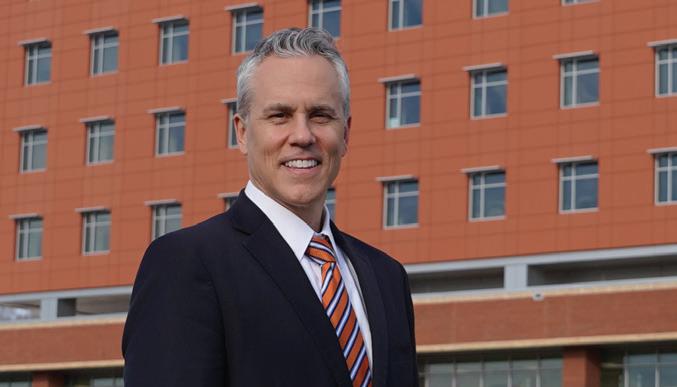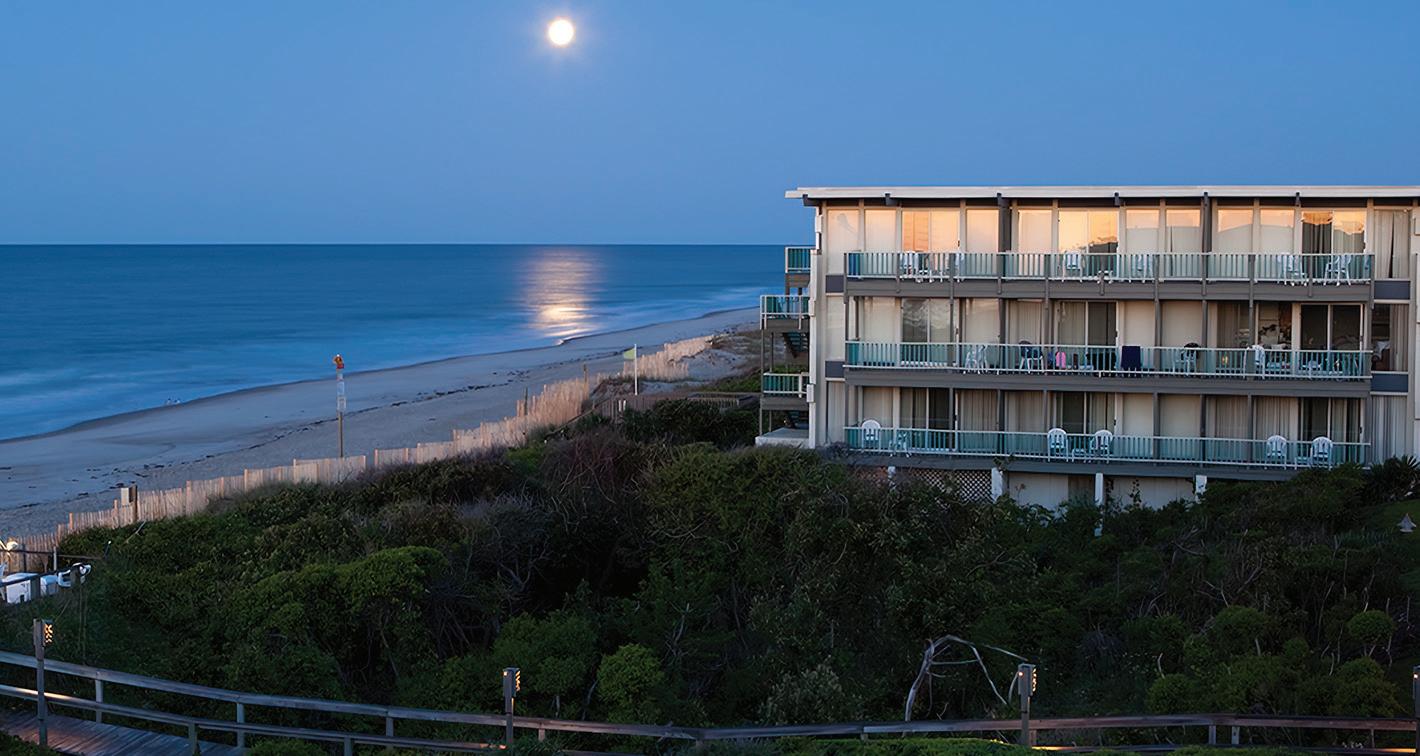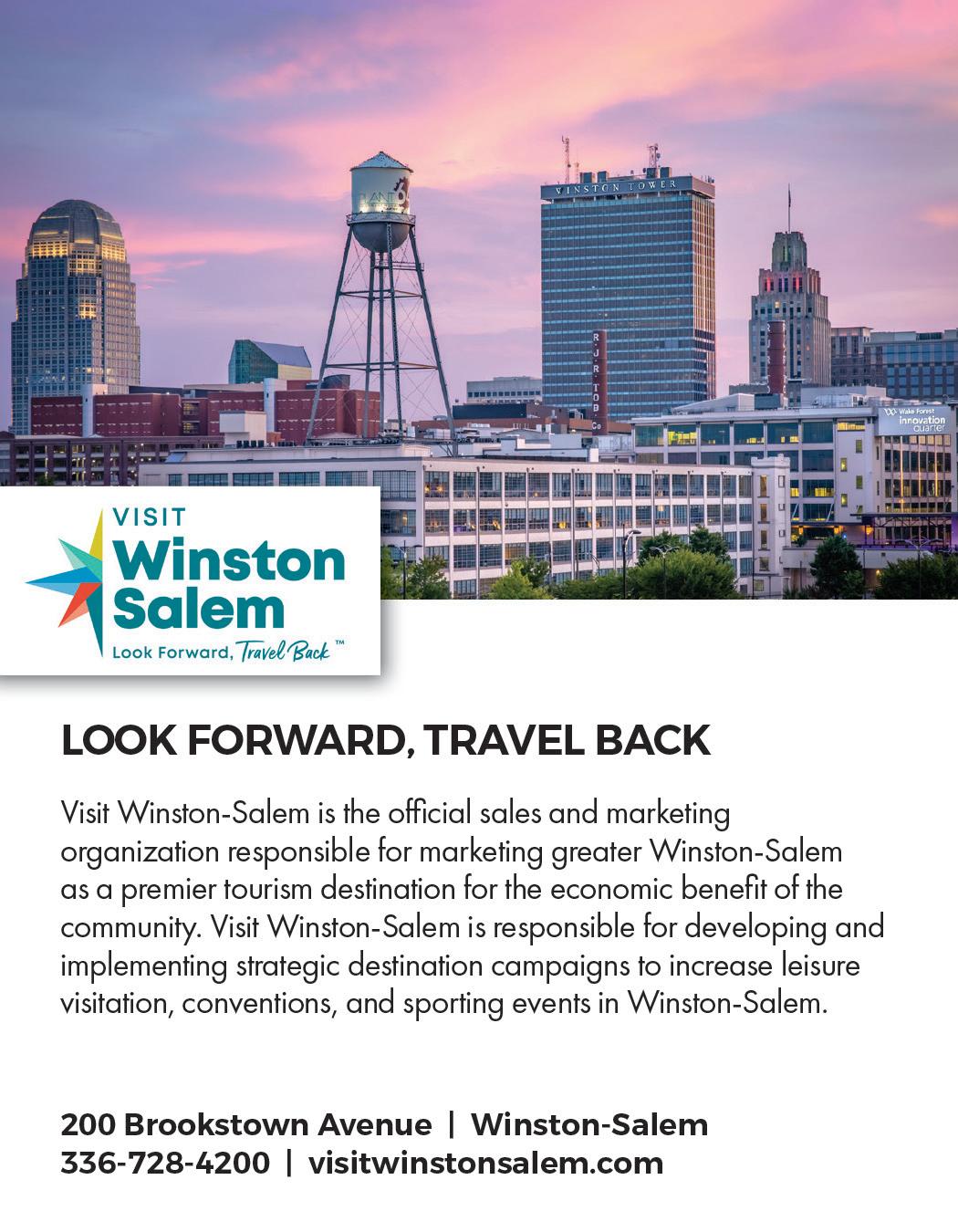READY TO ROLL
Severe staffing shortages spur demand for ‘travel nurses’ and cause service and financial turmoil at N.C. hospitals.

















Price: $3.95 businessnc.com MARCH 2023 GREENSBORO GLORY: CONE HEALTH TOPS HOSPITAL RANKINGS LOCAL MALT STIRS BEER BIZ | MURALS’ MAGICAL IMPACT | ROBIN TEAM TREASURES THE TRIAD



4 UP FRONT
6 POINT TAKEN
The Fleet Readiness Center East packs a powerful punch for the military and Eastern North Carolina.
10 POWER LIST INTERVIEW
Developer Robin Team shares tricks of the trade as he builds a Triad real-estate development business.



12
ENERGIZERS
Unbox the Dress helps brides aiming to update their family treasures.
14
NC TREND


Year of the trail; Why pickleball is going nuts; Two Burke County loyalists start a newspaper; A Raleigh startup helps dogs avoid cancer; Roy Cooper’s fundraising prowess and N.C. Tribune news.
94



GREEN SHOOTS

Renovation of an old textile mill weaves new hope in Bessemer City.

34 UPWARD BOUND

The N.C. Community College System ensures development of a strong statewide workforce.



70 DESTINATION NC
More company travel and leisure trips ditch by-the-book itineraries for more authentic experiences.

82 FARMING NC
Farmers find a profitable business model selling directly to consumers, raising the industry’s profile.
COVER STORY
SHORT STORY
Too few nurses are causing severe service and financial problems at N.C. hospitals.




 BY EDWARD MARTIN
BY EDWARD MARTIN
BEST HOSPITALS


Moses Cone Hospital in Greensboro tops BNC’s annual Best Hospitals rankings.
BY KEVIN ELLIS, DAVID MILDENBERG AND EBONY MORMAN


STANDING FIRM
HCA’ s top N.C. executive defends the company’s Tar Heel expansion.

 BY DAVID MILDENBERG
BY DAVID MILDENBERG
GRAIN BELT

Asheville’s Riverbend Malt House connects the state’s farmers and brewers for tastier suds.
 BY DES KELLER
BY DES KELLER
IN LIVING COLOR
From cities to small towns, N.C. muralists are adding culture and color to cultivate community.
 BY EBONY MORMAN
BY EBONY MORMAN
3 MARCH 2023 March 2023, Vol. 43, No. 3 (ISSN 0279-4276). Business North Carolina is published monthly by Business North Carolina at 1230 West Morehead Street, Suite 308, Charlotte, NC 28208. Phone: 704-523-6987. All contents copyright © by Old North State Magazines LLC. Subscription rate: 1 year, $30. For change of address, send mailing label and allow six to eight weeks. Periodicals postage paid at Charlotte, NC, and additional offices. POSTMASTER: Send address changes to BUSINESS NORTH CAROLINA 1230 West Morehead Street, Suite 308, Charlotte, NC 28208 or email circulation@businessnc.com. Start your day with business news from across the state, direct to your inbox. SIGN UP AT BUSINESSNC.COM/DAILY-DIGEST.
44 54
52 60
64
MARCH 2023
UP FRONT Ben Kinney

MURAL SUPPORT
Itravel a lot across the state. Obviously nature calls on some of these trips, and I usually make a stop at one of our state’s outstanding rest areas if I can, rather than a convenience store. ( ey can sometimes be a little o -putting depending on which one you choose).
North Carolina's rest stops are clean, neat and seem to be pretty safe on the occasions I’ve visited. ey should be, of course. In many cases, these are some of the only places that many folks will see as they travel through on their way to someplace else. We should build upon these locations in a few innovative ways to promote the state and our culture.
Let’s customize these places to represent the state even more. As I said, they are nice, clean and safe, but they are pretty bland because all of them look the same. How about if we add a little color and personality to each one and hire a mural artist to work on a wall or two at our rest areas? is would add some pep, as you’ll read in Ebony Morman's story, starting on page 64, on how murals are popping up across the state, both
in cities and small towns. ey add a real creative element to each place, such as the downtown Raleigh mural pictured above. Wouldn’t something similar be cool at each rest area? It could even represent some neat aspect of the state or region where the rest area is located.

While we’re at it, how about if we pump in some music highlighting North Carolina musicians? ink about if the Avett Brothers, John Coltrane, Nina Simone, Doc Watson or Eric Church were featured on a continuous loop over loudspeakers in the entrances, restrooms and picnic areas across the state? What a great representation of music across so many genres.
We’ve got a good thing going in terms of a nice place for visitors to stop and rest, use the facilities or walk the dog. We should build up that foundation and add a little spice to the mix. ink of it as a little Texas Pete on your barbecue sandwich.
PUBLISHER
Ben Kinney bkinney@businessnc.com
EDITOR
David Mildenberg dmildenberg@businessnc.com


MANAGING EDITOR
Kevin Ellis kellis@businessnc.com
ASSOCIATE EDITOR
Cathy Martin cmartin@businessnc.com
SENIOR CONTRIBUTING EDITOR
Edward Martin emartin@businessnc.com
SPECIAL PROJECTS EDITOR
Katherine Snow Smith
CONTRIBUTING WRITERS
Dan Barkin, Connie Gentry, Des Keller, Ebony Morman, Carroll Walton
CREATIVE DIRECTOR
Peggy Knaack pknaack@businessnc.com
CONTRIBUTING GRAPHIC DESIGNER
Emily Harding
MARKETING COORDINATOR

Jennifer Ware jware@businessnc.com
ADVERTISING SALES
ACCOUNT DIRECTOR
Melanie Weaver Lynch, eastern N.C. 919-855-9380 mweaver@businessnc.com
ACCOUNT MANAGER AND AUDIENCE DEVELOPMENT SPECIALIST
Scott Leonard, western N.C. 704-996-6426 sleonard@businessnc.com
CIRCULATION: 818-286-3106
EDITORIAL: 704-523-6987
REPRINTS: circulation@businessnc.com
BUSINESSNC.COM
OWNERS
Jack Andrews, Frank Daniels III, Lee Dirks, David Woronoff, in memoriam Frank Daniels Jr.
PUBLISHED BY Old North State Magazines LLC

4 BUSINESS NORTH CAROLINA
PRESIDENT David Woronoff VOLUME 43, NO. 3
Contact Ben Kinney at bkinney@businessnc.com. MURAL CREDIT: "ABSTRACTED MOTION” BY TAYLOR WHITE, RALEIGH

BEST-KEPT SECRET
In February, the Eastern Carolina Aviation Heritage Foundation held a fundraiser at the Havelock Tourist & Event Center, with proceeds to promote STEM education. e speaker was Mark Meno, executive director at Fleet Readiness Center East, the Navy’s aviation overhaul and repair depot. His talk was headlined: “Eastern NC’s Best Kept Secret!”
With some 4,000 workers, including 1,000 engineers, FRC East has been around for 80 years. You might think something so important to the state wouldn’t be much of a secret.
“Not a lot of people even know about it,” says Keith Wheeler, executive director of East Carolina University’s O ce of National Security & Industry Initiatives. He calls it “one of the largest, most awe-inspiring facilities that we have.”
e depot is a Navy-run facility on Marine Corps Air Station Cherry Point, about 15 miles down the Neuse River from downtown New Bern. It takes up about147 acres as a tenant of the air station, also home to the 2nd Marine Aircra Wing. FRC East’s 119 buildings cover 2.1 million square feet. It is probably going to get bigger as more h-generation ghters, the F-35, arrive for overhauls and repairs.
FRC East bills its military customers about $1 billion a year,

and has a payroll of about $330 million. e average salary is $72,000 a year, nearly 28% more than the median household income in Craven County.
Meno, the top civilian executive at FRC East, came to the depot a er graduating from Virginia Tech in 1994. He sums up its signi cance this way: “It is the largest aeronautical services, logistics and engineering services provider in North Carolina. It is the largest industrial employer east of (Interstate) 95.”
SOME HISTORY
FRC East started out with 36 employees in 1943, part of the construction of Marine bases along the coast of North Carolina, from Havelock to Jacksonville. By war’s end, nearly 3,800 workers were repairing planes at Cherry Point. In 1969, it was designated the Naval Air Rework Facility. It became the Naval Aviation Depot in 1987 and FRC East in 2006. Nearly all the employees are civilians; many are veterans.
FRC East does work on aircra from all over the military, but about 75% of its workload is maintenance and overhaul of Marine aircra . One variant of the F-35 is the Marines’ version, the F-35B, the short-takeo /vertical landing aircra that is replacing the
6 BUSINESS NORTH CAROLINA
POINT TAKEN Dan
Barkin
The Fleet Readiness Center East packs a powerful punch for the military and Eastern North Carolina.
The V-22 Osprey aircraft
Harrier. A construction project at FRC East is a lift fan test facility for the F-35B.

Military aircraft are intended to fly a long time. The F-35 may go past 2070. They last because out of every five-year cycle, they visit a place like FRC East for about six months, get taken apart down to the air frame, refurbished and upgraded. That’s the industrial part of the depot.
Then there’s the engineering part. Say there’s a mystery vibration in a helicopter.
“You call an engineer . . . [who says], ‘Send us the data; we’re looking at it. Swap out this component. Testfly it again. Yeah, the warning went away. Great, off you go.’ That kind of instant response, touch and support is what we also provide,” says Meno.
Sometimes the engineers are trying to put monitoring systems on helicopters that were built 40 years ago. Or they have to get old aircraft and new ones to communicate and collaborate in the battle space. For the engineering and logistics folks at FRC East, “that’s the bread and butter of their business,” says Meno. “They create all of the instructions and documentations and modification packages and designs, so when it comes into an industrial facility and gets ripped down and built back up, it’s done repeatedly, effectively and in a way that can be maintained.”
SCHEDULES AND SURPRISES
When you start overhauling an aircraft on a tight deadline, you can get surprises. Corrosion may be worse than expected. You may need a part that isn’t in inventory. Scheduling is always a challenge.
“The way we have to operate, we’ve got one plating shop and one cleaning shop and one paint shop. And everybody’s stuff is coming in and out of those places. That requires a lot of logistics and coordinating,” Meno says.
It all seems to work out. Last year, FRC East overhauled each of the 60 aircraft that it was supposed to.
“Engines, we did I think 82 out of 86, and the four that fell out were, they changed the schedule
on us. We were supposed to do a little over 10,000 components. We did 11,000-ish, so we overshot our component numbers.”
Meno is also proud of the depot’s improved safety record. In 2002, there were 800 instances of reported injuries a year. Last year there were 36. “We had a few commanders who came in 10-15 years ago that said, well, we can’t keep doing this to our people.”


GOING TO GLOBAL TRANSPARK
Space has been at a premium at FRC East. Two years ago, the depot opened a satellite operation at the state’s Global TransPark in Kinston to overhaul Air Force UH-1 “Huey” helicopters. This enabled the depot to open up scarce hangar space in Havelock for its V–22 Osprey and H-53 heavy-lift helicopter programs.
A bigger partnership between GTP and FRC East could be afoot. That would boost Kinston and the TransPark as the hub of an Eastern North Carolina aeronautics industrial corridor — the center in a cluster of military and civilian aviation facilities, supplied by technicians trained at community colleges and engineers from universities like N.C. State and East Carolina University. Building a reliable workforce for this cluster is one reason 29 school systems and 14 community colleges joined NC East Alliance’s STEM East Network in January in Greenville.
The TransPark had its origins as a Kinston auxiliary airfield to train Marine pilots, before transitioning into a small public airport with a few commercial flights. In the early 1990s, state officials hoped that the airport, with its 11,500-foot runway, could become the hub of a manufacturing and logistics complex — the Global TransPark — where companies would fly in unfinished products, then fly the finished goods all over the world. That didn’t take off. But steadily, it has attracted aeronautics and aviation tenants, with a major charter jet company, flyExclusive, and Spirit AeroSystems, a
7 MARCH 2023
Keith Wheeler
Mark Meno
PHOTO COURTESY OF FLEET READINESS CENTER EAST
An F-35B Lightning II , a short takeoff-vertical landing jet flown by the United States Marine Corps, awaits disassembly before modification at FRC East. Jets are refurbished every five years, ensuring lots of work at the site.
POINT TAKEN Dan Barkin
supplier to Airbus. Lenoir Community College received a $25 million appropriation for an aviation training center at GTP.
Against this backdrop, GTP and FRC East are discussing a project that could bring in Navy and Marine C-130s work now done at an Air Force facility in Utah.
“One of the options being discussed, still being discussed, is the Navy and Marine Corps taking back their C-130 work, and FRC East being responsible for that work,” says Meno. “Those aircraft are pretty large so they require construction of hangars.”

Norris Tolson is the head of the GTP board and CEO of the Carolinas Gateway Partnership, an economic development group in Edgecombe County. The Huey project “went very well,” he notes. “We’ve got the runway and we’ve got plenty of space around this, and the security’s pretty good there. We’ve been having some pretty heavy-duty discussions with FRC.”
Asked what this could mean for employment, Meno estimated perhaps 500 more people added over five to seven years. That could include more staffers in Havelock, Kinston and Onslow County. That would be significant for Eastern North Carolina because these are good jobs.
THE BRAC JITTERS
From the late ‘80s until the mid2000s, the military went through something called BRAC, a term that sent shudders through base towns everywhere. It stands for Base Realignment and Closure. The last one was 2005. Given the work coming with the F-35 and the V-22 Osprey, FRC East may be as essential as it has ever been, but one BRAC legacy is organizations like Allies for Cherry Point’s Tomorrow. The ‘93 BRAC was a particularly jittery one. Some 1,600 depot employees went to Norfolk, Virginia to a BRAC hearing.
James Norment, a New Bern attorney who has lobbied to support Cherry Point, says the BRAC 30 years ago “showed the community that if the military wanted to close it, they could close it. Now of course, that was a long time ago. Memories fade.”


Awareness of the depot west of Interstate 95 tended to be highest during BRACs. Mary Beth Fennell, a retired FRC East engineer, recalls when the operations made the front page of my old paper, The News & Observer of Raleigh, in 2003. In the opening paragraph, the story posed the question: What would state leaders give to lure an aerospace plant with 4,000 high-paying jobs?
THE FUTURE
There will also likely be some significant construction for FRC East at Cherry Point to accommodate the rising F-35 work.
The center of activity will be across a runway from the depot’s buildings, on about 100 acres that used to be housing. The first of two F-35 hangars is being designed now. It is planned to have 20 bays. Groundbreaking may take place in another year or two, with occupancy in the 2027 timeframe.
“That will be the first large hangar-sized industrial, huge facility on that side of the runway,” says Meno. That, plus nine existing bays, would give the depot 29 bays for F-35 work. He expects to see another building with 14 bays. “So, in the end, we’d have a little over 40 bays for F-35s versus the nine we have now.”
“And if this hypothetical plant were to plop down in Eastern North Carolina, where high-paying jobs are scarce,” the story continued, “the celebration in Raleigh might well last for days. Thing is, that industry — the Naval Air Depot at Marine Corps Air Station Cherry Point — is already there, and the state’s most vital economic development campaign in the next two years might be trying to protect it and other military facilities from a major round of base closings that will be announced in 2005.”
That was 20 years ago, and, as Norment says, memories fade. A lot of the folks living in Raleigh and Charlotte have arrived here since the BRAC days. A lot of folks drive through Havelock on the way to Crystal Coast beaches and have no idea that on the left side of U.S. 70, behind the gates, is Eastern North Carolina’s best-kept secret. ■
8 BUSINESS NORTH CAROLINA
Veteran journalist Dan Barkin went to high school in Newton, Massachusetts, arrived in the South for college in 1971 and moved to North Carolina in 1996. He can be reached at dbarkin53@gmail.com.
Mary Beth Fennell
FRC East employs about 4,000, including 1,000 engineers.

with Nido Qubein at High Point University

TRICKS OF THE TRADE
Developer Robin Team joined High Point University President Nido Qubein in the Power List Interview, a partnership for discussions with some of the state’s most influential leaders. Interview videos are available at www.businesssnc.com.
You have tentacles across the Triad. What is your secret?
Robin Team is managing partner of Front Street Capital, which has developed notable projects such as the 400 Bellemeade office building in Greensboro and Bailey South office/retail center in Winston-Salem. The Wake Forest University graduate’s company has raised more than $200 million in equity with “zero investor losses,” the company website notes.

Team’s sons Alston and Coleman are partners in Front Street along with Jonathan Starnes and Matt McInnis and Principal Lori Starnes. During the interview, Qubein noted that Team has done “a masterful job of bringing together the Triad region” with projects across the region. This story includes excerpts from Team’s interview and was lightly edited for clarity.
In a single word, “relationships.” We’ve developed relationships with all the municipal bodies in the Triad. We’ve got builders, architects and engineers. We treat those folks as if we’ve been doing business with them forever — and, quite frankly, we have.
What got you into this business?
IcameoutofcollegeandIwenttoworkforBB&Tforashort while.BB&Tbasicallyputmethroughamaster’sinfinance,andI foundthatinvaluable.ThenIspentastintinthefurniturebusiness inmarketingandadvertising,whichgavemeinsightsintothatarea. ThenIwenttoworkforalocalLexingtontaxattorneywhowasalsoa realestatedeveloper.Hetaughtmethetricksofthetrade.
IeventuallydecidedIwantedtotrytogooutandtryanddoiton myown.Herewearetoday.
What was your first project?
WebuiltthefirstbuildinginGreensboroforReplacementsLtd. Threeyearslaterweexpandedthatbuildingforthemagain.Whata successstorytheyhavebeenforourcommunities.
How have you financed your projects?
Wehaveastableofinvestors,folksthathavebeenveryloyaltous overtheyears.Wetryandkeepatleast10%ofeachdealourselves. Weinvestrightalongwithourinvestorcadre.Itmakesthemfeel comfortable.Italsohelpsuswithourbottomline.
10 BUSINESS NORTH CAROLINA
LIST INTERVIEW
What have been your firm’s specialties?
We started out doing an awful lot of medical office space in Winston-Salem for quite some time. We then morphed into generalpurpose office space. Lately the hottest sector in real estate has been industrial, so we focused on that for the last five or six years.
The Carolina Core is seeing tremendous development demand because of Toyota Battery, Boom Supersonic, HondaJet and others, right?
We think it’s going to be a pent-up demand, quite frankly, and our focus is developing for the ancillary companies that will be suppliers and business partners of those companies. Those are going to be tremendous economic drivers.
There are lots of smaller projects that don’t get quite the notoriety. Nucor is building a new facility in Davidson County and there are a couple of other big things on the horizon.
Do these new companies all want to be close to an airport and highways?
They certainly want to have the transportation infrastructure to be successful. For a lot of companies, rail is their single-most important component. So if you’ve got a rail site, you’ve got a real valuable commodity.
Are you optimistic about our state and the Carolina Core?
Yes, the Carolina Core has an industrial background and heritage that is greatly valued by the companies that are looking at our region. There are not many regions that have that background.
The two biggest drivers in where a company is going to go are the availability of land and proximity to airports and highways. The other driver is workforce. We’ve got incredible universities in the Triad, including High Point University, right here. They turn out a lot of degrees every single year.
Our challenge is to make sure that all of those bright young people that are coming out of schools, including our community college systems, think that the Triad is a wonderful place to live and grow and raise a family. So in addition to building industrial facilities, we try to enhance the lifestyles of the communities that we’re fortunate enough to work in. We’re building somewhat of a lifestyle center in downtown Winston-Salem that’s part of the Innovation Quarter.
Charlotte has done an incredible job with its center city, and Raleigh, too. Is the Triad behind them?
I think we’re like the third horse coming around the last turn in a race, and they’re looking over their shoulders at us. You know, we have advantages that Raleigh and Charlotte don’t have, and I think that our industrial heritage is one of them.
Do the mega-sites provide an edge?
Exactly right. And the workforce that has worked in the industrial facilities in the past. Our road infrastructure is second to none. I’m a fairly impatient person, and when I go to Raleigh, and certainly when I go to Charlotte, and I get cooped up in a car in traffic, it drives me crazy. We don’t have those problems here.
Greensboro, Winston-Salem, and High Point have been anticipatory in their traffic development. We just opened the last leg of the Greensboro loop, I believe. Ten years ago people wondered why we needed that. Today, it’s a reality and it’s going to solve the problems that traffic might have created 10 to 20 years from now.
How do you decide on starting a project?
We built the first high-rise in downtown Greensboro in over 30 years, right beside the Greensboro Grasshoppers baseball field. When we started, we had one tenant that was going to take two floors of the nine-story building. So, it was a big roll of the dice for us. It was definitely a risky project compared to a fully-baked industrial deal that has a 10- to 15-year lease with a Fortune 500 company.
We finished the shell construction of that building about three months before this little event called COVID-19 hit, so it brought a whole different set of challenges. But we have pretty much filled that building up over the last couple of years, and it is a wonderful opportunity with new innovative office space for folks in downtown Greensboro to look at as an alternative.
We’ve gone through a little self-study with our company in the last year and our core purpose has been coined “Shaping the built environment to enrich our communities.” I am very proud of the young folks on our executive team for coming up with that as our main purpose, and they’re putting our communities maybe even ahead of our company.
Have you had projects that didn’t meet goals?
We certainly had a couple of office projects that COVID slowed down. We had a little bit more capital needs toward the end of those projects as they were leased up. So, that dilutes your return on investment a little bit.
Tell us about current market conditions.
There are periods of time where you anticipate a recession, and I guess we’re in one of those times right now. If you read the newspapers every day, that seems to be the banner headline in the business sections. A lot of times, it’s a self-fulfilling prophecy. The media can sometimes talk the consuming public into a little bit of a recession. But we don’t think there is going to be a recession in North Carolina.
We don’t think there’s going to be hardly a blip in the industrial radar in the Triad because we’ve got such dynamic forces at work. We feel like the Triad is going to continue to be a very, very successful story.
You’ve built a family business. Are you still friends with your kids? Are you paying them enough?
It depends on who you ask on any given day. I told my boys when they graduated from college that our business was an opportunity for them, but it wasn’t an obligation. And I said, “go work for somebody else for a while. Get your nose bloodied a little bit, and then if you want to come back and work for the company, the door will always be open.” I’m lucky that they both are very talented and they both have different talents that complement each other.
I’ve got a couple of other young men who are part of our executive team that complement the two of them very well. It’s really not a family business anymore, except that everybody that works here feels like we are a part of the Front Street family.
Why do you live in Lexington?
It’s where I grew up. My dad was an old-fashioned solo practice family doctor, and I went to Lexington Senior High School and then went on to Wake Forest. I guess I tried to move away. While I was working for BB&T, they said, “We really need you back in Lexington.” So, I moved back and grew my own roots there. It was a great place to raise a family and go to school and develop deep church roots. It’s just a quintessential small, southern town. ■
11 MARCH 2023
ENERGIZERS
BRIDAL UPCYCLE
Unbox the Dress helps brides aiming to update their family treasures.
 By Connie Gentry
By Connie Gentry
The wedding business is reinvigorated after the pandemic pause, making it prime time for Grace Lightner, 32, to build a Winston-Salem business that repurposes vintage wedding dresses. Her vision is to turn thousands of grandmothers’ lace gowns from the 1950s or mother-of-the-bride’s 1980s satin sensations into keepsake heirlooms for contemporary brides.
Lightner and her mother, Lorraine Stewart, started Unbox the Dress in 2018 to sell sentimentality, but with an online platform and creative process that has been strategically positioned to become a national brand.
“This business is built on nostalgia and wrapped in sentimentality, but we’ve done a lot of work to do this in a way that is scalable,” says Lightner. That includes intellectual property that encompasses a 250-page production manual, quality standards and customer care training with a goal of never having an unhappy customer.
“Our research told us 70% of married women in the U.S. are storing at least one, if not multiple, wedding dresses — that’s when we realized this could be a national brand, because no one else was owning this concept and there was a universal need.”
The average bridal gown, regardless of its era, provides 6 to 7 yards of satin and lace that can be changed into complementary wedding accessories, a rehearsal dinner dress, or the best-selling “getting ready robe.”
Last year, the average bride spent $1,635 on her wedding dress,
while the average cost of weddings topped $28,000, including receptions, according to The Knot online wedding website.
The duo says a key to success was picking Winston-Salem after a search that included Atlanta; Greenville, South Carolina; and Danville, Virginia. A $50,000 grant in 2020 from the Durham-based NC IDEA entrepreneurs’ support group helped pave the way, complemented by the availability of skilled seamstresses and designers. Such grants require an in-state residency, so Lightner and Stewart moved from North Canton, Ohio, in 2020 and 2021, respectively.
“We considered Charlotte, but the cost of square footage would have meant we had to locate an hour outside of the city versus being in downtown Winston-Salem,” Lightner says.
The company quickly outgrew a 4,500-square-foot space, relocating last July to a 12,500-square-foot facility near Wake Forest University.
On any given day, some 400 wedding dresses are moving through the company’s plant. Revenues reached $1 million in 2022 and Unbox the Dress had processed 7,000 customer orders since its inception. Brides from all 50 states have used the service. It typically takes 10 weeks to fill orders.
The company also provides a “Save to Transform” service that provides cleaning and storage for modern brides to hold their wedding gowns until they’re ready to have them remade into an anniversary dress or a christening gown.
12 BUSINESS NORTH CAROLINA
Enterprising young Tar Heel entrepreneurs.
In September, Unbox the Dress expanded into the highend market after some advisory board members suggested the company could charge higher prices, says Stewart. She is the founder and owner of Cleveland-based Rojek Consulting, a 32-year-old marketing firm that lists UPS, GM and other big companies as clients.



“We tried to stratify our pricing to see where customers gravitate and there are people who will pay [premium] for a one-of-a-kind tabletop handbag that’s unlike any other purse a mother of the bride could carry on her daughter’s wedding night,” Stewart says.

The “luxe” line pricing ranges from $650 to $900 for a couturequality piece; the heirloom christening gown starts at $800. Across the company’s product offering are options in the $50 range, including bowties, pocket squares, and bouquet wraps. Their customers spend, on average, $550 to $600.
“This is a trust–based business, and we knew we could be the leaders, the experts, in this space,” says Lightner. She is a 2013 graduate of Northwestern University, which is also her mother’s alma mater.
Early on they decided to grow the company through venture capital. Along with the $50,000 NC IDEA grant, they’ve raised
COMPANY Unbox the Dress
FOUNDERS Grace Lightner, CEO
Lorraine Stewart, chief strategy officer
HEADQUARTERS: Winston-Salem
LAUNCHED: 2018
EMPLOYEES: 30
2022 REVENUE: $1 million
AVERAGE SALE: $550 - $600
about $1 million from friends, family and First Launch Capital, a Greensboro-based venture fund, and want to raise another $400,000 this year, Lightner said in late January.
Meanwhile, she’s mulling opening a second production site that would expand their pool of seamstresses, possibly in the Triangle or Asheville.
“Building a national brand is a bit of a race against time,” Stewart says. “The further out in front we are when we go from 7,000 customers to 15,000, and the more we’ve built the category and are recognized as the leading national and online brand in wedding dress redesign, the more challenging and expensive it is for someone to duplicate.”
The owners also envision expanding into new lines such as commemorative keepsakes of baby blessings. But the main focus is on the wedding niche, which is marked by some interesting trends such as increasingly extended engagement periods.
“January is a huge bridal month because of newly engaged women and October is the No. 1 month for weddings, so backing up from that, think of all the showers and parties,” Lightner says. About 17% of weddings in the U.S. occurred in October last year, the sixth straight year it has been the most popular month, according to The Knot. ■

13 MARCH 2023
PHOTO CREDITS: LIZ NEMETH, JENN EDDINE AND LIGHT OF YOUR LIFE PHOTOGRAPHY
Co-founders Grace Lightner (left) and Lorraine Stewart (right) specialize in wedding and celebration apparel, but have expanded to add handbags (opposite page) and other accessories. The signature “Getting Ready Robe” is a popular seller, while the clutch purse is made from a 1980s wedding dress. A team member creates patterns surrounded by client dresses.
TRAIL TRICKS
Cities big and small find greenways to be a savvy path to success.
 By Kevin Ellis
By Kevin Ellis

People noticed changes occurring in Rutherfordton when the Purple Martin Greenway neared completion three years ago. A bicycle shop opened, an ice cream store changed locations to be nearer the trail. A developer won town approval in 2019 to build Park Crossing, a 180-unit apartment complex at one end of the greenway.
None of that would have happened if not for a two-mile paved path that connects two parks, says Doug Barrick, town manager of the town of 3,600 residents that is 55 miles southeast of Asheville. It allows visitors to explore wildlife, creeks, waterfalls and local plant life, not far from downtown.

“It hasn’t happened overnight, but it’s growth that’s in line with what our rural community’s needs are,” says Barrick, in his ninth year of leading the town.
Big cities like Charlotte and Raleigh, along with small towns like Rutherfordton, are using greenways as a way to improve quality of life for current residents, and attract tourism dollars and new businesses.

With that in mind, North Carolina lawmakers designated 2023 as the “Year of the Trail,” a celebration of greenways and paddleways. It’s also a nudge to prompt residents to visit a greenway, state park or recreation area to hike, bike, ride a horse or even paddle a kayak in this geographically diverse state.
ere’s plenty of money in all of this, too. People spend $28 billion annually on outdoor recreation in North Carolina, according to the Economic Development Partnership of North Carolina. Tourism related to trails also sustains more than 160,000 North Carolina jobs, according to the Year of the Trail organization.
A mix of 60 state organizations, nonpro ts and businesses, including NC State Parks, VisitNC, and State Employees’ Credit Union, are helping to support the Year of the Trail campaign with special events. e Great Trails State Coalition, a group that lobbies for more state spending on trails, wants to promote events in all 100 counties with tie-ins for local governments and businesses.
Local governments say greenways can improve the physical health and well-being of residents, while also easing road congestion and serving as an economic development tool. Since 2014, Charlotte and Mecklenburg County have been working to create the Cross Charlotte Trail, a 30-plus-mile greenway from Pineville through center city and north to the UNC Charlotte campus and Cabarrus County. It is costing more than $110 million including land acquisition and construction.
e Cross Charlotte Trail will add to Mecklenburg County’s existing 66.7 miles of greenways and put 140,000 residents and 130,000 jobs within walking distance of the trail. While Mecklenburg County has hundreds of miles of both paved and natural surface trails, the Cross Charlotte Trail, would allow residents to travel without a car from one end of Charlotte to the other. City leaders hope this addition will make Charlotte nationally recognized among the top 25 U.S. cities with the most multi-use trails.
Raleigh’s Capital Area Greenway System has more than 100 miles of greenways, highlighted by the 27.5-mile paved, uninterrupted Neuse River Greenway that stretches from Falls Lake in North Raleigh to the Johnston County line in southeast Raleigh. Also popular in the Triangle is the 22-mile

14 BUSINESS NORTH CAROLINA NC TREND ››› Tourism
14 Tourism 16 Sports 18 Communications 22 Technology 24 Public affairs 28 Statewide
American Tobacco Trail that connects Durham, Cary, Apex and other areas.
Back in Rutherford County, the 13.5-mile Thermal Belt Rail Trail connects Forest City, Spindale, Rutherfordton and Ruth. More than 100,000 people use the trail annually, and it is particularly popular with bicyclists.

“Unfortunately, our trail counters don’t differentiate between residents and tourists, but our suspicion is it’s about fifty-fifty based on how the numbers go up on the weekends,” Barrick says.
The trail along an old rail line cost $7 million to build, and was completed in 2019. More than 90% of the funding for the trail came from the RHI Legacy Foundation, which was formed after the community’s hospital was acquired by Duke LifePoint Healthcare in 2014.
About two-thirds of Rutherford County’s population lives within a mile of the Thermal Belt trail, Barrick says. The two greenways have been homeruns for the county abutting South Carolina.
“Our goal was to provide an avenue for community wellness, so our residents would have a better quality of life,” he says. “These trails help bring people together. We’ve really seen it come together to build community.”

The trails also have been “great for business,” according to Barrick, including nearby restaurants and a bicycle shop.
“People say all the time that we want to grow, but we want to keep that small-town feel,” Barrick said. “These trails have helped create a sense of community. They build a camaraderie with folks.” ■
TRAIL INCLUSION
The Year of the Trail includes support for several organizations that promote efforts to make everyone feel comfortable in the outdoors.
Outdoor Afro is a national organization focusing on inclusion in outdoor recreation. North Carolina has chapters in Asheville, Charlotte, Raleigh-Durham and the Triad.
Black Folks Camp Too was started in Brevard after its founder Earl Hunter went on an epic camping road trip across the U.S. and Canada and saw only one other Black family at a campground.
Issa Vibe Adventures began with three friends in Charlotte who wanted to make nature more inclusive to Black people. They organize hikes in Charlotte and across the state.
Black Girls Do Bike has seven N.C. chapters in North Carolina with an especially active group in the RaleighDurham area. The group champions cycling for women, especially those of color.
Latinos Aventureros en las Carolinas began with two friends in Gastonia and Morganton who took their first hike during the pandemic in 2021. The group hosted 98 events in 2022, mostly centered around hiking. Open to everyone, it offers information in Spanish to help Spanish speakers feel comfortable.
Wheelchair and stroller accessible trails at state parks can be found by Googling the phrase “state parks with accessible trails.”

15 MARCH 2023
Thermal Belt Rail Trail
QUITE THE RACKET
Step aside, tennis, there’s a new sport catching on.
By Carroll Walton
Pickleball is like tennis without the pretense. Badminton, but people actually play it. Or pingpong with exercise.

e sport that’s been described as a combination of the other three is catching on in a big hurry. More than 36.5 million Americans played pickleball from August 2021 to August 2022, according to a recent report by the Association of Pickleball Professionals.








To understand why, here is a closer look at the new craze that boasts being greater than the sum of those parts — even to many faithful tennis a cionados.
“I have a tennis court in my backyard. We use it to collect leaves,” says Connie Barnes, who with her husband owns the Charlotte Squash Club. She had converted a tennis court to a pickleball court before a lease ran out. She and many others gravitated to pickleball during COVID, when she was looking for something easy to play and a social activity with some distance involved.
While squash is still her profession, pickleball is a passion. “I’ve played with badminton players, tennis players, squash players and pingpong players and it is incredible fun,” Barnes says. “We can trash talk all day. We drink mimosas while we’re down there. It’s extremely relaxing and fun. We just love it.”
Players are standing in line to play around Charlotte. at is the sport’s greatest challenge: not enough courts to meet the demand. North Carolina has 418 pickleball courts at recreation centers, gyms and private clubs, according to Pickledheads.com, which tracks the industry and sets up leagues. at’s the fourth-most of any state and includes more than 25 courts in Charlotte. But it’s not enough right now.
In December, Allan and Kelly Haseley opened Pickleball Charlotte Ballantyne, the city’s rst indoor facility dedicated to pickleball. ey have three Pickleball Charlotte locations,
serving 3,000 local players. Ballantyne is on a court used exclusively for pickleball, while their south Charlotte and northside locations converted courts from other sports.
Haseley, who met his wife playing recreational volleyball at UNC Chapel Hill, used to mark volleyball courts in the Granite Street Sports Center in south Charlotte for pickleball during the school day, so retirees could play. en players started asking about nights and weekends, and not just retirees. Courts rent for an average of $10 per person for two-hour sessions. Lessons are typically $30 to $60 an hour.
Pickleball Charlotte has six instructors, and a waiting list for people who want beginner lessons and clinics. “We’ve had no open space since the day we opened Dec. 15,” Haseley said. is has happened in a matter of three years, since the Haseleys needed new ooring for the gym and visited peer sites to get some ideas. What they noticed was an intriguing new sport being played with a little yellow ball.
“I’ve done every sport in the world and pickleball is the only one I’ve done the last 20 years that every time I play, I feel like I get better,” Haseley says. “Every time I play golf, I get worse. I can’t play volleyball anymore.”
KEEPING THE KIDS BUSY
Pickleball isn’t new. Two fathers in Bainbridge Island, Washington, came up with the idea while looking to entertain their children in 1965. ey had access to a badminton court but not enough rackets, so they picked up pingpong paddles and a wi eball.
16 BUSINESS NORTH CAROLINA NC TREND ››› Sports
According to the U.S.A. Pickleball Association, there is a running debate on how pickleball got its name. One explanation goes that co-inventor Joel Pritchard’s wife, Joan, thought the game reminded her of a pickle boat in rowing, which features oarsmen leftover from other crews. Barney McCullum, a family friend who helped establish the sport’s rules, has said it was named for Pritchard’s dog Pickles, who used to run off with the ball in the middle of a game. Right from the start, everybody wanted to play.
A pickleball court is 20 feet by 44 feet, smaller than a volleyball court. The games can be played as singles but are most often doubles, so each player covers less ground. The cardiovascular workout tends to be less than a tennis match.
The net is several inches shorter than in tennis, and the ball is served underhanded, which makes the game immediately accessible to new players. The difficult aspect, some say, is the scoring system, but once that is understood, the games go fast. A game is played to 11 points and might last 15 minutes.
Four pickleball courts can fit on one tennis court, so 16 players can play one pickleball game in 11 minutes, while 16 people wait for the next, compared to only four players using that same court for a tennis match that could take hours.
“The heydays of tennis have come and gone, and I see this all over the world,” said Barnes, a native of Brisbane, Australia. “I was in Australia three weeks ago, having the same discussions with the
same people looking at the same tennis courts with no one on them and looking at pickleball players standing in line wanting to play.”
Haseley plans to expand with another indoor pickleball facility in north Charlotte. A local company called Rally plans a pickleball and eating establishment in the South End neighborhood this spring, with plans for four indoor courts, four outdoor courts and lots of food and drink.

Even tennis hotbeds like Olde Providence Racquet Club and Myers Park Country Club have converted tennis court space for pickleball. Some country clubs have kept their tennis clientele happy by converting hard courts to pickleball and keeping clay courts for tennis.
That is the plan at the Jewish Community Center, which converted two hard tennis courts to pickleball and set up three courts inside a gym.
“The tennis people, actually, when it rains, will come inside and play pickleball,” said Stephanie Garner, the JCC’s athletics director.
Pickleball is featured as a “ladies night” activity while the “open play” on their schedule draws a crowd, not to mention a good time.
“People don’t take it as seriously as they do other sports,” Garner says. “They just really have a nice time playing. And the beauty is you can be a beginner and be intermingled with people that know what they’re doing. And people that know what they’re doing are really good about pushing the sport along and trying to get more people playing.” ■
17 MARCH 2023
A NEW NEWSPAPER, REALLY?
 By Kevin Ellis
By Kevin Ellis
Publisher Allen VanNoppen and Editor Bill Poteat smiled like proud papas as they waited for the rst run of their new baby, e Paper, to come o the press on the rst Friday in February.

As newspapers shut down at an alarming rate, VanNoppen, a marketing executive, decided to launch the weekly in his hometown of Morganton, a Blue Ridge Mountains foothills town of 17,500. He pulled Poteat out of semi-retirement to help.

“It’s something that I have thought about doing, dreamed about doing and talked about doing for four years,” says VanNoppen, while waiting at e Charlotte Observer printing site as 3,000 copies rolled o the press. “My wife nally said to me, ‘If you don’t do this now, you’re going to regret not doing it.’”
e Burke County natives would each grab 150 papers before leaving Charlotte for the twilight drive home. Starting at 8 the next morning, they began distributing their allotment of e Paper at places where locals hang out like Timberwoods restaurant and Sain’s Barber Shop in Morganton’s downtown.
e two describe their venture as a “Back to the Future” attempt to bring an old-fashioned newspaper into a world dominated by digital media. Since 2005, the country has lost more than a fourth of its newspapers (2,500) and is on track to lose a third by 2025, according to a report published last year by the Northwestern/Medill Local News Initiative.
Forty-one North Carolina newspapers have shut down during that time, says Penny Abernathy, a visiting professor at Northwestern University’s Medill School of Journalism, who led the Journalism and Digital Media Economics program at UNC Chapel Hill from 2008 to 2020. e most recent closing was e Belmont Banner in Gaston County, which last printed Nov. 10 a er 86 years of publication.
“It was the best paper in the land. Everyone was very sad when it went out, me included,” says former Banner Managing Editor Alan Hodge. “I poured my heart and soul into it for 16 years. Now there’s a huge void of local news in this community.”
e country has 6,380 surviving papers: 1,230 dailies and 5,150 weeklies, but they are disappearing at a rate of more than two per week, the Northwestern report states. Newsroom sta s have declined 60% in that time. Circulation numbers have decreased signi cantly as revenue and pro ts evaporate.
ree things will help a newspaper to survive, Abernathy says. e paper’s leadership must be able to respond quickly to its community, the circulation area needs to be growing in population and a uence, and the backers must have su cient capital to survive for about ve years, she says.
Burke County has about 88,000 residents, a decrease of around 2,500 people from the 2010 census. ose residents have been getting their news for more than 130 years from e News Herald, which still prints six days a week in Morganton. Like many newspapers, e News Herald has undergone several corporate ownership changes and is now owned by Davenport, Iowa-based Lee Enterprises. Lee owns 77 papers in 26 states. Seven others are in North Carolina, including Winston-Salem, Greensboro and Hickory.
Lee Enterprises fought o a hostile takeover bid last year from New York-based hedge fund Alden Global Capital, but its nancial struggles have worsened. Axios reported Lee Enterprises started telling some newsroom employees on Feb. 13 they would have to schedule an unpaid, two-week furlough by the end of February.
e Paper and e News Herald will compete for readers and advertising dollars. VanNoppen and Poteat believe an appetite
18 BUSINESS NORTH CAROLINA NC TREND ›››
Communications
Burke County natives say their locally-owned weekly can dislodge the incumbent daily.
PHOTO CREDIT: KEVIN ELLIS

exists for more local news, and feel local ownership can make a difference. Local ownership has been a strength of newspapers that continue to thrive, says Abernathy.
“Inside The Paper, there’s 32 pages of local news, 40 bylined stories,” says VanNoppen of the first edition. The Paper will only cover news in its county. “Burke County News. Burke County Owned,” states the masthead.

“A promise we made to our readers was that they would not see a word about Hickory, Atlanta or Afghanistan, on our pages,” says VanNoppen. (Hickory is about 20 miles east of Morganton.)
In The Paper ’s first edition, Poteat tells the story of a reunion of the 1965-66 Morganton Lady Wildcats, who won a state basketball championship in the first year Black and white students attended school together. Another story profiles the county’s principal of the year. On the front page of sports, readers were introduced to the new Patton High football coach and learned of a high schooler who competed for a state wrestling championship in the 100-pound class in her senior year. (The female wrestler, Freedom High senior Jeulenea Khang, won the title.)
VanNoppen was a reporter at The News Herald for a few months when he met Poteat, who joined the paper as a reporter in 1980. VanNoppen would leave for a job at the Greensboro News & Record, while Poteat stayed in town and later became editor for 18 years before leaving in 1999 to teach English at a local high school.
Poteat retired after 18 years of teaching, and worked as a parttime columnist for The Gaston Gazette, now owned by Gannett, owner of hundreds of newspapers in 45 states, including USA Today, and headquartered in McLean, Virginia.
VanNoppen left reporting in 1985 and became a furniture executive with Hudson-based Kincaid Furniture, owned by La-Z-Boy, and Century Furniture, based in Hickory. In 2001, he founded VanNoppen Marketing in Morganton, which he still owns.
The two men reconnected last summer. VanNoppen had been meeting with people in the community for a year about his plans to start The Paper when he asked Poteat to lead the newsroom. The Paper has nine employees, including five in the newsroom.

VanNoppen declined to detail his investment, but says that costs from inception through March will total around $150,000. He expects The Paper to break even within a couple months of its launch.
The Paper operates as a limited liability company with a couple of 501(c)(3) fiscal sponsors. It is VanNoppen’s intention to form a purpose-focused 501(c)(3) to accept grants and donations that are designated for local journalism efforts.
Eventually, VanNoppen wants to distribute part of the ownership to investors, employees, and, through membership subscriptions, to readers.
“It’s a sense of ownership, much like the (NFL’s) Green Bay Packers are owned by the community,” says VanNoppen. “That was our model of ownership, so subscribers will have a say of who is nominated for the board of directors, who is nominated for the 25-member editorial community committee.”
An annual subscription to The Paper costs $225 for home delivery and online access, and $119 for digital-only. Subscribers can pay an extra $70 per year, or $295 total, to have a voice in the direction and content of The Paper.
Van Noppen’s goal is to achieve 3,000 paid subscribers. Advertising revenue in initial editions have exceeded his original projections.
“The launch and related community response has been extraordinarily awesome and complimentary,” he says. “We are ahead of budget on all fronts — subscriptions, ads, community engagement.” ■
Kevin Ellis worked at The News Herald from 1988 to 1996. Poteat later worked as a part-time reporter and columnist at The Gaston Gazette, where Ellis was the editor.
20 BUSINESS NORTH CAROLINA
NC TREND ›››
Communications
PHOTO
Editor Bill Poteat, top, and Publisher Allen VanNoppen, right, look at the first edition of The Paper as it comes off the press in February.
CREDIT: KEVIN ELLIS

21 MARCH 2023
PROTECTING FIDO
By David Mildenberg
Six million dogs are diagnosed with cancer annually, so Raleigh-based Animal Cancer Dx sees a potentially big market for its early detection test. It’s the latest venture of Raleigh investor Chan Namgong, who is a former chief operating o cer at the Johnson Automotive dealership group and owner of two startup businesses, Commercial Space Management and HomeCloud.
Namgong worked with Daniel Midki , a North Carolina State University research assistant, to develop the test. About 30 Triangle clinics and hospitals use the technology.

Where did you grow up?
I grew up in Seoul, South Korea, then moved to Raleigh when I was 15 in 2000. I’ve lived in Raleigh ever since. I went to Ravenscro and got a business degree from UNC Chapel Hill.
You’ve called your dad your biggest in uence. Tell us about him. He started young as an entrepreneur, and sold furniture parts and made real estate investments in Korea. When we moved to the U.S., he bought a struggling clothing store, and made it very successful.
What has been your dad’s best advice?
He’s always believed in me and encouraged me to take risks. He would point out opportunities that I would dismiss otherwise. Had I not taken his advice, there could have been many times I would have regretted so much. His best advice has been “work hard and stay humble.”
What sparked your interest in animal cancer?
A er my mom was diagnosed with breast cancer, I read a lot about cancer detection and cancer treatment. One day, I came across a peer-review journal where a group of scientists used C. elegans (a small nematode roundworm) to detect cancer in human urine. It sounded too good to be true, and sparked my interest.
Instead of going straight to the human space, I wanted to run a proofof-concept in the veterinary space, which didn’t have any cancer screening test options at that time. A veterinarian friend and I found a company in
Oregon that can run the proof-of-concept experiments. ey came back with promising data, and the rest is history.
Who else works at the company?
We have another full-time lab technician. We have a team of 13 scienti c advisers. ey are veterinary professors, clinical veterinary oncologists, and general practice veterinarians.
How did you convince 30 Triangle clinics to use your product?
It wasn’t too di cult because it’s a tool that they had been needing for a very long time. We have a competitor called PetDx that also has a multicancer screening test. ey are a venture capital-backed biotech company based in San Diego.
You can think of them as Goliath and us as David. We are bootstrapped and haven’t raised any money yet. We have two major advantages over PetDx. We only need 1 milliliter of urine whereas they require 15 milliliters of blood. And our retail price is between $99 to $199 depending on the hospital, while there’s is $1,000 to $1,200.
We’ve added two clinics in Knoxville, Tennessee. We are talking to a couple of clinics in Charlotte.
People love their pets. Will they keep spending more on them?

Absolutely. Morgan Stanley published a study about the growth of the pet industry. ere are more innovations happening in the industry, and they are going to bring down the costs overall.
How much capital have you raised? PetDx has raised $62 million.
We haven’t raised any yet. I personally put in $500,000 and have gotten $60,000 grants from NC IDEA and $100,000 from the N.C. Biotech Center. We are looking to do an angel round in early to mid-2023, and a seed round in 2024. I’ve been very thoughtful about raising capital given the economic environment.
How can your test be more e ective than more expensive rival?
Our mission is to make our test reliable, a ordable, and accessible to as many pets as possible. In order to achieve our mission, the cost is very important. We are trying very hard to keep our overhead costs down and not waste money on corporate bells and whistles. ■
A Raleigh pet-cancer testing company says it can save loving owners some big bucks.
22 BUSINESS NORTH CAROLINA NC TREND ›››
Technology

TRIBUNE
INDEPENDENT INTELLIGENT INFORMATIVE




Our paid daily newsletter provides detailed interviews with key lawmakers, Q&As with other political leaders and lots of stories tracking daily happenings at the state legislature as the 2023 long session gets under way. Here’s some of what you missed. Sign up today at nctribune.com.
SHOW ME THE MONEY
Which Council of State member raised the most money in the second half of 2022? It wasn’t one of the two gubernatorial hopefuls, Lt. Gov. Mark Robinson or Attorney General Josh Stein. at distinction goes to Gov. Roy Cooper, who wasn’t on the ballot last year and likely won’t be in 2024. But his campaign organization was a key player in Democrats’ fundraising e orts. It raised $3.9 million between July and December and spent $5 million during that time, according to campaign nance reports led last week. His campaign has largely functioned as an outside fundraising e ort for the N.C. Democratic Party, which then spent the money on key midterm legislative and judicial campaigns. e Cooper campaign transferred about $4.5 million to the state party in the second half of 2022.

Millions of dollars from that organization went to Cooper’s campaign. Top donors there in 2022 included Raleigh businessman Dean Debnam ($250,000), the United Auto Workers ($125,000), Burlington businessman Sam Hunt ($100,000), Chapel Hill insurance executive Adam Abram ($50,000), author John Grisham ($50,000) and the Catawba Indian Nation ($35,000).
CORRECTION NEEDED
PLACE YOUR BET
A er a near miss last year, sports betting legislation could be among the hot topics as the long session cranks up.
Rep. Jason Saine, R-Lincoln and a sponsor of the measure, said that he expects the proposal “will look a lot like the bill from last year.” But one key change could create tensions between two competing factions among sports betting proponents, both of which have dra ed teams of in uential lobbyists.

WRAL recently reported that the state’s professional sports teams want the legislation to automatically allocate them eight of the 12 available licenses, which would limit the number of licenses available to national gambling operators such as FanDuel and Dra Kings.
Lobbyist Ches McDowell has been working on the behindthe-scenes push to legalize sports betting for years. He works for a subsidiary of the law rm Kilpatrick Townsend & Stockton, and got his start in politics working for Senate leader Phil Berger.
McDowell and his team, which also includes former House Speaker Tim Moore adviser Nelson Freeman, represent most of the sports organizations seeking to o er betting: the Charlotte Hornets, the NBA, Charlotte FC soccer, Major League Baseball, Churchill Downs and the PGA Tour.
Another group, the Sports Betting Alliance, likely wants to keep the earlier language on gambling license allocations. e group includes companies like FanDuel, Dra Kings and BetMGM. Its North Carolina lobbyists are former gubernatorial candidate Patrick Ballantine and UNC System Board of Governors member David Powers.
e N.C. prison system’s 40% sta vacancy rate was a key focus at the Senate con rmation hearing for Secretary of Adult Corrections Todd Ishee.
Ishee was approved to lead a cabinet position created when last year’s state budget called for prisons, probation and parole to become a separate agency from the Department of Public Safety. He has been the state’s commissioner of prisons since 2019 and previously spent decades working in the corrections system in Ohio.
“Our rst goal has got to be around improving our sta ng levels,” he said. e state is o ering employees recruitment bonuses with a goal of getting the vacancy rate below 20% in the next four years.
24 BUSINESS NORTH CAROLINA NC TREND ›››
Public affairs
CAROLINA
NORTH
Governor Roy Cooper
Todd Ishee

EMPLOYERS, TAKE NOTE:
PUMP and PWFA provide broader protections for pregnant and nursing employees.
 By Ken Gray and Avery Locklear
By Ken Gray and Avery Locklear
On December 29, 2022, President Biden signed the Consolidated Appropriations Act of 2023, which included two laws expanding federal employment protection to mothers: Pump for Nursing Mothers Act and Pregnant Workers Fairness Act.
PUMP FOR NURSING MOTHERS ACT ("PUMP")
PUMP went into effect on December 29, 2022, providing additional protections for employees who need to express breastmilk. While preexisting laws only covered non-exempt workers, PUMP now extends protection to all employees.
PUMP requires an employer to provide a nursing employee with reasonable time to express breastmilk in a private
location (other than a restroom) for up to one (1) year after the nursing child's birth. PUMP does not require that the private location be permanent, just that nursing employees have a space shielded from view and free from coworker and public intrusion.
Employers are not obligated to compensate an employee during the break time unless (1) an employer is required to do so under another state or federal law, (2) an employee expresses breastmilk during a paid break, or (3) an employee is not completely relieved from their duties during the entirety of the break.

Employers with less than 50 employees can still rely on the small employer exemption if compliance would impose an undue hardship.

SPONSORED SECTION 26 BUSINESS NORTH CAROLINA
PREGNANT WORKERS FAIRNESS ACT ("PWFA")
PWFA guarantees accommodations for pregnant workers— mirroring the protections for disabled workers under the Americans with Disabilities Act ("ADA"). PWFA applies to employers with 15 or more employees and will go into effect on June 27, 2023.
PWFA's protections are similar to those already found in the ADA. For compliance with the PWFA, an employer needs to engage in an interactive process to provide a reasonable accommodation to employees and applicants with known limitations associated with a physical or mental condition related to pregnancy, childbirth, and other medical conditions.
Like the ADA, PWFA uses the term "qualified employee" meaning an applicant is able to perform the essential functions of their employment positon with or without a reasonable accommodation. However, an employee or applicant will also be considered qualified when: (1) the inability to perform an essential function is for a temporary
period; (2) the essential function could be performed in the near future; and (3) the inability to perform the essential function can be reasonably accommodated.
Additionally, PWFA prohibits employers from requiring an employee to take paid or unpaid leave when a reasonable accommodation exists or requiring the employee to accept an accommodation other than the reasonable accommodation arrived at through the interactive process. Further, PWFA protects employees from adverse action or retaliation against an employee or applicant on account of using or requesting an accommodation.
Employers should revisit their ADA policy to ensure it is compliant with the PWFA and that the procedure to request a reasonable accommodation under PWFA is similar to those already in place under the ADA.

With the enactment of PUMP and PWFA, employers will need to review their policies to ensure compliance with both laws. For guidance on how to ensure policies do not violate PUMP and PWFA, employers should consult legal counsel. ■
Ken Gray
Ken leads the firm's Labor and Employment Practice Group. His practice experience encompasses various areas of employment-related litigation. He advises clients and litigates cases involving all forms of employment discrimination, wrongful discharge, and breach of employment contracts from small start-up companies to Fortune 500 corporations. He is a graduate of Campbell Law School.
Avery Locklear
Avery has a diverse practice that focuses on labor and employment law. She helps businesses of all sizes, as well as individual employers and human resources professionals. Avery is committed to finding practical, efficient solutions to the challenges that employers face every day. She is a graduate of the University of North Carolina School of Law.

Avery Locklear
ajlocklear@wardandsmith.com wardandsmith.com
27 MARCH 2023
Ken Gray smg@wardandsmith.com
CHARLOTTE
CHARLOTTE
More than $6.9 billion of apartments, offices and various projects are planned for Charlotte’s Uptown and South End area, according to a Charlotte Center City Partners report. Plans call for 7,700 apartments, including 2,600 currently under construction. Developers also have pitched 7.2 million square feet of office space. Hotels with 670 units are under construction, with another 1,600 proposed.



E4 Carolinas CEO John Morrison resigned on Feb. 13. The Charlottebased energy industry association’s board appointed Lori Collins, founder of Collins Climate Consulting, as interim director until a successor is found.

Truist sold a 20% stake in its insurance subsidiary for $1.95 billion to the Stone Point Capital private equity firm. Mubadala Investment is also investing with Stone Point. The deal values Truist Insurance at $14.75 billion.
KANNAPOLIS
Charlotte-based Trinity Capital, in partnership with Barings, will build the 85 Exchange industrial park here. It will have 1.3 million square feet across seven buildings. Phase One comprises two buildings totaling 314,000 square feet and should be completed by early 2024. It’s about a mile from Interstate 85.
GASTONIA

Atlanta-based Newell Brands opened a 1.5 million-square-foot, $135 million distribution center. The consumer goods company, with brands including Rubbermaid, FoodSaver and Calphalon, was the first to commit to NorthPoint Development’s Gateway85 industrial park. The company employs about 150 workers now, and plans to reach 185 employees. The U.S. Postal Service and Amazon also plan to operate at the site.

HICKORY
Appalachian State University plans to hire 23 full-time faculty positions for its campus here opening in the fall, Chancellor Sheri Everts says. The university will make available more than 100 undergraduate majors on the 16-acre campus it acquired for $1 million in 2021. App State enrolls almost 20,500 students at its Boone campus. The project received $9 million in nonrecurring funding in the most recent state budget.

BELMONT
Belmont Abbey College launched a $100 million capital campaign. The private Catholic college has already raised $70 million, and will use the money to build residence halls, update a performing arts center, and build a monastery for its Benedictine monks. The college had

28 BUSINESS NORTH CAROLINA NC TREND ››› Statewide
PHOTO COURTESY OF GASTON COUNTY ECONOMIC DEVELOPMENT AND BELMONT ABBEY COLLEGE
about 1,400 undergraduate students in 2022. It also wants to create a private financing system to replace federal student loans and limit government oversight.
STATESVILLE

Water Tech, an Arkansas-based water treatment company that focuses on food processing facilities, announced a $10.8 million investment to better serve customers on the East Coast. Water Tech will build a 50,000-square-feet building and hire 26 people at its fourth facility, but first in North Carolina.

EAST
WILMINGTON

Following a record-breaking year for the local tourism industry, a new marketing campaign by the Wilmington and Beaches Convention and Visitors Bureau aims to build on the momentum. The effort is funded from the record collection of $22.6 million in room occupancy taxes in the last fiscal year.

from having access to his property for 45 days. The court held that the ban did not physically appropriate the plaintiff’s beach house.
DUDLEY
interstate standards in Craven County. The state Department of Transportation will improve 6.4 miles of the highway that serves the Global TransPark in Kinston, several military installations, the Port of Morehead City, and beach communities.
GREENVILLE
ment rights, a federal appeals court ruled. Dare County prevented non-resident property owners from entering the county, which kept Joseph Blackburn Jr.
A large fire scorched at least 30 acres Feb. 11 at an industrial site here, about nine miles south of Goldsboro. Firefighters from 23 departments responded to the fire at National Salvage and Service, which recycles railroad ties. No one was injured in the fire.

NEW BERN
A $242 million state contract will bring another segment of U.S. 70 up to
East Carolina University Health will close five clinics in March after its rural health division lost $46 million in the 2022 fiscal year. The locations include clinics in Snow Hill, Jacksonville, Aurora, Wilson, and Williamston. ECU Health blamed a disproportionate number of uninsured and underinsured patients, along with the cost of travel staff.
FAYETTEVILLE
The Fayetteville Observer is shutting its “entire production operation” as of April 10 and will lay off 56 employees, according to a notice filed with the state. The newspaper is owned by Gannett. The publication said it would be printed at The Gaston Gazette in Gastonia beginning in April.
29 MARCH 2023
TRIAD
LEXINGTON
Navis TubeTex, which manufactures finishing machinery for the textile industry, earned the Award for Excellence in the 2022 Governor’s Export Awards for its business success with international markets. North Carolina companies exported more than $40 billion in goods and services last year to more than 200 countries. Navis TubeTex has customers in more than 65 countries.
GreatLife Golf of Camp Hill, Pennsylvania, took over management of Sapona Golf and Swim in western Davidson County and agreed to buy the club in January 2024. Uber executive Mark Moore bought it from NASCAR team owner Richard Childress in 2018.
MOUNT AIRY
Radio station WPAQ 740 AM celebrated 75 years on the air Feb. 2 with a concert featuring bluegrass musicians. The 10,000watt station was started by the late Ralph Epperson and is now run by his son, Kelly Epperson.
WINSTON-SALEM
Ziehl-Abegg, a German manufacturer of ventilation systems, generators and other equipment, said it is investing more than $100 million into a plant here. At least 300 jobs will be added as a result of the expansion, company officials said.
Wake Forest University chemistry professor Elham Ghadiri received a $650,000 research grant to be distributed over five years from the National Science Foundation. Ghadiri is developing new laser techniques, which have applications to improve solar energy conversion devices.
GREENSBORO


Colorado-based Boom Supersonic broke ground on its Overture factory at a 62-acre campus at the Piedmont Triad International Airport. It will include a final assembly line, test facility, and customer delivery center with as many as 2,400 employees by 2032, the company projects.
BURLINGTON
Bed Bath & Beyond is closing five more N.C. stores, including one here, as it deals with major financial pressures. The home decor company had 953 stores last year, including 21 in North Carolina. The company has announced plans to close stores in Charlotte, Gastonia, Greenville, Hickory, Raleigh, and Wilson.
TRIANGLE
DURHAM
Shares of G1 Therapeutics dropped sharply after it reported disappointing clinical trial results for its lead cancer drug. The company ended a phase 3 trial because the drug failed to outperform the placebo.
Kempower, a Finnish company that manufactures charging stations for electric vehicles, will invest $41 million and create 300 jobs here. Kempower will start producing its fast-charging units later this year. North Carolina plans to have at least four fast-chargers every 50 miles on major highways.
WINSTON-SALEM
Salem Academy and College raised more than $15 million for its capital campaign, exceeding its original goal of $12.5 million. The money will support student scholarships, update important student areas and renovate the historic RondthalerGramley House.
Meta, the parent company of Facebook and Instagram, plans to hire 100 people at the American Tobacco Campus. WRAL Techwire reported last year that Meta was looking at a “significant presence” in the Triangle.

30 BUSINESS NORTH CAROLINA NC TREND ››› Statewide
PHOTO
OF
COURTESY
SALEM COLLEGE

NC TREND ›››
Statewide
Telecommunications company Avaya filed for bankruptcy for the second time in six years, listing both assets and liabilities of $1 billion to $10 billion. The company also secured $780 million in financing as it restructures its business. Avaya expects to complete the process in 90 days and serve customers without interruption.
MONCURE
Vietnamese automaker VinFast says it will move ahead with construction of its auto factory after approval of an air quality permit from state regulators. The company has pledged to spend $4 billion and employ as many as 7,500 people, aided by $1.25 billion in state and local incentives. Production is scheduled to start in mid-2024.

SANFORD
Automotive supplier Bharat Forge plans a 150,000-square-foot expansion and as many as 100 more jobs on its workforce of 250. Bharat Forge makes aluminum components for companies including Ford, Toyota and MercedesBenz. The India-based company has said the plant may eventually employ 460.
RALEIGH


On-demand car services company Spiffy added $30 million in capital following a fundraising round led by Edison Partners. The company started by veteran tech executive Scot Wingo previously raised $32 million over the last two years.
An online app that connects willing baby sitters with parents will expand into the Triangle area. Wyndy launched
in 2017 in Birmingham, Alabama, and has since completed more than 100,000 jobs across the Southeast. The company connects parents with college students who have undergone background checks and have at least a year’s experience. On average, sitters earn $16 an hour.
CARY
Heritage Capital Partners plan a mixed-use development of 600 mid-rise apartments, a 175-room hotel, 400,000 square feet of office space and 50,000 square feet of retail space on a 48-acre piece of property off N.C. 55, It will be near Apple’s planned East Coast engineering hub.
SOUTHERN PINES
The Town Council approved construction of 10 golf cottages with a total of 52 rooms on the Southern Pines Golf Club. The ownership group led by Kelly Miller intends for guests to play Southern Pines Golf Club, Mid Pines and Pine Needles golf resorts.
WEST
ASHEVILLE
HomeTrust Bancshares completed its $70.8 million purchase of Quantum Capital, a Georgia bank with about $600 million in assets. HomeTrust now has $4.3 billion in total assets.
“Dual-employee” school bus drivers remained on the job after Asheville City Schools bumped its monthly stipends by 250% for the remainder of the year, from a $200 allowance up to $700 a month. Dualemployee drivers put in hours elsewhere in the district, but drive bus routes in the morning, afternoon or both. Four of the district’s 17 dual-employee drivers threatened
to resign if pay was not increased. Full-time drivers received the same $500 increase, with those who drive only in the morning or afternoon receiving hikes from $250 to $350.
The city council is discussing how to fund at least $30 million of improvements of its McCormick Field minor league baseball stadium. Team owner Brian Dewine wants upgrades at the stadium, which ranks among the worst nationally according to Major League Baseball’s facility standards.
LINVILLE
Grandfather Mountain, which attracts about 300,000 visitors each year to its “milehigh” swinging bridge, animal habitats and miles of hiking trails, shifted to a dynamic ticketing system that will cost visitors less during unpopular times and more during what are considered “in-demand days.” Tickets will range from $15 to $28, depending on the season and holidays.

Pactiv-Evergreen plans to scale back production by idling one of its four papermaking machines, the Smoky Mountain News reported. Officials suggested the move could be tied to a continuing contract dispute between the company and its unionized workforce. ■

32 BUSINESS NORTH CAROLINA
PHOTOS
COURTESY OF VINFAST, PACTIV-EVERGREEN AND TODD BUSH

“With 58 colleges serving 100 counties, North Carolina community colleges provide diverse talent pipelines for industry sectors across the state. The future of business is in strong hands with highly prepared employees, customizable short-term programs, and committed graduates building our communities.”



 – Dr. Bill Carver Interim President, North Carolina Community College System
– Dr. Bill Carver Interim President, North Carolina Community College System
SPONSORED SECTION 34 BUSINESS NORTH CAROLINA
UPWARD BOUND
North Carolina’s economic success is underpinned by its skilled workers. The N.C. Community College System ensures development of a strong workforce. More than 500,000 students studied at the system’s 58 campuses during the 2021-2022 academic year. Many enrolled in classes and programs geared toward specific industries and companies, a strategy employed by the system for more than 50 years. Discover how that approach improves communities and lives through the following examples.





35 MARCH 2023
COMMUNITY COLLEGES ACROSS THE STATE


ALAMANCE COMMUNITY COLLEGE Burlington, Graham | alamancecc.edu
ASHEVILLE-BUNCOMBE TECHNICAL COMMUNITY COLLEGE
Arden, Asheville, Candler, Marshall, Woodfin abtech.edu
BEAUFORT COUNTY COMMUNITY COLLEGE Washington | beaufortccc.edu
BLADEN COMMUNITY COLLEGE Dublin | bladencc.edu
BLUE RIDGE COMMUNITY COLLEGE
Brevard, Flat Rock, Hendersonville blueridge.edu
BRUNSWICK COMMUNITY COLLEGE
Bolivia, Carolina Shores, Leland, Southport brunswickcc.edu
CALDWELL COMMUNITY COLLEGE AND TECHNICAL INSTITUTE Boone, Hudson | cccti.edu
CAPE FEAR COMMUNITY COLLEGE
Burgaw, Castle Hayne, Hampstead, Wilmington cfcc.edu
CARTERET COMMUNITY COLLEGE
Morehead City | carteret.edu
CATAWBA VALLEY COMMUNITY COLLEGE
Conover, Hickory, Newton, Taylorsville cvcc.edu
CENTRAL CAROLINA COMMUNITY COLLEGE Dunn, Lillington, Pittsboro, Sanford, Siler City cccc.edu
CENTRAL PIEDMONT COMMUNITY COLLEGE Charlotte, Huntersville, Matthews | cpcc.edu
CLEVELAND COMMUNITY COLLEGE Shelby | clevelandcc.edu
COASTAL CAROLINA COMMUNITY COLLEGE Jacksonville | coastalcarolina.edu
COLLEGE OF THE ALBEMARLE
Barco, Edenton, Elizabeth City, Manteo albemarle.edu
CRAVEN COMMUNITY COLLEGE Havelock, New Bern | cravencc.edu
DAVIDSON COUNTY COMMUNITY COLLEGE
Bermuda Run, Lexington, Mocksville, Thomasville | davidsonccc.edu
DURHAM TECHNICAL COMMUNITY COLLEGE Durham, Hillsborough | durhamtech.edu
EDGECOMBE COMMUNITY COLLEGE
Rocky Mount, Tarboro | edgecombe.edu
FAYETTEVILLE TECHNICAL COMMUNITY COLLEGE, Fayetteville, Fort Bragg, Spring Lake faytechcc.edu
FORSYTH TECHNICAL COMMUNITY COLLEGE Kernersville, King, Walnut Cove, Winston-Salem forsythtech.edu
GASTON COLLEGE Belmont, Dallas, Lincolnton | gaston.edu
GUILFORD TECHNICAL COMMUNITY COLLEGE Colfax, Greensboro, High Point, Jamestown gtcc.edu
HALIFAX COMMUNITY COLLEGE Weldon | halifaxcc.edu
HAYWOOD COMMUNITY COLLEGE Clyde | haywood.edu
ISOTHERMAL COMMUNITY COLLEGE Columbus, Rutherfordton, Spindale isothermal.edu
JAMES SPRUNT COMMUNITY COLLEGE Kenansville | jamessprunt.edu
JOHNSTON COMMUNITY COLLEGE Clayton, Four Oaks, Smithfield | johnstoncc.edu
LENOIR COMMUNITY COLLEGE Kinston, La Grange, Pink Hill, Snow Hill, Trenton lenoircc.edu
MARTIN COMMUNITY COLLEGE Williamston, Windsor | martincc.edu
MAYLAND COMMUNITY COLLEGE Burnsville, Newland, Spruce Pine | mayland.edu
MCDOWELL TECHNICAL COMMUNITY COLLEGE Marion | mcdowelltech.edu
MITCHELL COMMUNITY COLLEGE Mooresville, Statesville | mitchellcc.edu
MONTGOMERY COMMUNITY COLLEGE Troy | montgomery.edu
NASH COMMUNITY COLLEGE Rocky Mount | nashcc.edu
PAMLICO COMMUNITY COLLEGE Bayboro, Grantsboro | pamlicocc.edu
PIEDMONT COMMUNITY COLLEGE Roxboro, Yanceyville | piedmontcc.edu
PITT COMMUNITY COLLEGE Winterville | pittcc.edu
RANDOLPH COMMUNITY COLLEGE Asheboro | randolph.edu
RICHMOND COMMUNITY COLLEGE Hamlet, Laurinburg | richmondcc.edu
ROANOKE-CHOWAN COMMUNITY COLLEGE Ahoskie | roanokechowan.edu
ROBESON COMMUNITY COLLEGE Lumberton | robeson.edu
ROCKINGHAM COMMUNITY COLLEGE Wentworth | rockinghamcc.edu
ROWAN-CABARRUS COMMUNITY COLLEGE Concord, Kannapolis, Salisbury | rccc.edu
SAMPSON COMMUNITY COLLEGE Clinton | sampsoncc.edu
SANDHILLS COMMUNITY COLLEGE Pinehurst, Raeford, Robbins, Carthage sandhills.edu
SOUTHEASTERN COMMUNITY COLLEGE Whiteville | sccnc.edu
SOUTH PIEDMONT COMMUNITY COLLEGE Monroe Polkton, Wadesboro | spcc.edu
SOUTHWESTERN COMMUNITY COLLEGE Sylva | southwesterncc.edu
STANLY COMMUNITY COLLEGE Albemarle, Locust | stanly.edu
SURRY COMMUNITY COLLEGE Dobson, Elkin, Mount Airy, Pilot Mountain, Yadkinville surry.edu
TRI-COUNTY COMMUNITY COLLEGE Marble, Murphy, Robbinsville | tricountycc.edu
VANCE-GRANVILLE COMMUNITY COLLEGE Creedmoor, Henderson, Louisburg, Warrenton vgcc.edu
WAKE TECHNICAL COMMUNITY COLLEGE Cary, Morrisville, Raleigh, Wake Forest, Zebulon waketech.edu
WAYNE COMMUNITY COLLEGE Goldsboro | waynecc.edu
WESTERN PIEDMONT COMMUNITY COLLEGE Morganton | wpcc.edu
WILKES COMMUNITY COLLEGE Sparta, West Jefferson, Wilkesboro wilkescc.edu
WILSON COMMUNITY COLLEGE Wilson | wilsoncc.edu
SPONSORED SECTION 36 BUSINESS NORTH CAROLINA
65 YEARS OF AMAZING: GTCC CONTINUES TO UP THE BAR
Since 1958, Guilford Technical Community College has empowered students, employers, and the community through innovative education, training, and partnerships. GTCC offers over 80 programs of study in areas such as healthcare, technical trades, STEM (science, technology, engineering, and mathematics), and much more. After graduating from GTCC, students may also take advantage of seamless transfer pathways to four-year institutions in the state, including UNC Chapel Hill, N.C. A&T University, N.C. State University, and UNC Greensboro.
In the summer of 2023, GTCC will launch a groundbreaking partnership with FAME USA, giving students a new opportunity to earn while they learn. Students accepted into this highly selective program will work three days per week at a local sponsoring company and will spend two days per week in the classroom, earning their Advanced Manufacturing Technician certification and an associate of science degree. The best part: Participants receive a competitive salary during their experience, and often scholarship support, which means they will be able to graduate from GTCC debt-free. After five semesters, a majority of the cohort will be hired by their company directly after graduation, while others may choose to continue their education at a four-year institution.
In addition to the FAME USA partnership, GTCC offers many programs that promote workforce development in the Triad, in industries such as welding, mechatronics, aviation systems technology, computer-integrated machining, and more. Students may earn various credentials, including certificates, diplomas, and degrees, with additional opportunities for apprenticeships and work-based learning.
GTCC’s six campus locations and online course options give students across Guilford County the flexibility to study when and how they choose. Every campus offers state-ofthe-art equipment and cutting-edge curricula to proactively prepare students for their future careers. Students have access to many resources outside of the classroom as well, including free tutoring, financial assistance for non-academic needs, career coaching and resume workshopping, and job fairs to connect students with local employers.
In short, GTCC has a history of making amazing happen, and the future is looking brighter than ever for our students, our partners, and our community at large.


ABOUT GTCC:
Guilford Technical Community College is the fourth largest of 58 institutions in the North Carolina Community College System. Serving 27,000 students annually from six campuses and a Small Business Center, GTCC offers more than 80 programs of study, including flexible, low-cost options for earning associate degrees, diplomas, and certificates. GTCC is rooted in innovative education, training, and partnerships.

37 MARCH 2023
601 East Main Street Jamestown, NC 27282 336-334-4822 GTCC.EDU/WHYGTCC



SPONSORED SECTION 38 BUSINESS NORTH CAROLINA
SAMPSON COMMUNITY COLLEGE: BEGIN HERE, GO ANYWHERE

Since 1967, Sampson Community College’s (SCC) mission has been to provide accessible and affordable education, workforce training, and lifelong enrichment to all students in Sampson County, N.C. and beyond. The College currently offers numerous programs that can lead to various degrees, diplomas, certifications, licensures, skills, and transferable college credit.
During the Fall 2022 semester, over 1,600 curriculum students were enrolled at SCC, in addition to 500 students dually enrolled in the Career & College Promise (CCP) program and 230 at Sampson Early College High School (SECHS). Faculty-wise, the College currently employs around 140 full-time and 130 part-time faculty and staff members.

Thanks to partnerships with state officials, private organizations, and local community leaders, the College continues to work to enhance the learning experience students receive while attending SCC—most recently obtaining a new title from the U.S. Department of Education, two new facilities, and numerous new course offerings.
During the 2019-2020 academic year, Sampson CC became the first higher education institution in N.C. to be recognized as a full Hispanic Serving Institute (HSI)- serving a student body with over 25% Latinx students. SCC currently yields a 31% Latinx population enrolled in its curriculum courses, 23% in the CCP program, and 64% at SECHS. Considering this achievement, SCC continues to prioritize providing greater opportunities to the highest growing minority population in the region.
In Fall 2022, SCC debuted a brand-new Truck Driver Training facility and training pad tailored to fit all the growing program’s needs for student success. Located in Sampson Southeast Business Center, the College saw 38 students successfully enrolled. Since the program’s launch in 2007, 711 individuals have successfully completed the CDL course—making Sampson CC’s Truck Driver Training program one of the largest in N.C.

Also new to campus, the Sampson Trades Center completed construction in late 2022 with the long-term goal of housing more occupational programs. Anticipated programing for the facility is expected to be short-term electrical, HVAC, plumbing, small engine and short-term home repair, and masonry training. Seeing the growing need for education in trades, SCC recently introduced eight new vocational programs to its course offerings as well.
Sampson CC is committed to serving students and the community through outreach, innovative and effective teaching, student support, and community partnerships. With its constant growth, the College continues to remain one of the top community colleges in N.C.—providing numerous educational, occupational, and financial opportunities to all.
39 MARCH 2022
1801 Sunset Avenue Clinton, NC 28328 910-592-8081 SAMPSONCC.EDU



SPONSORED SECTION 40 BUSINESS NORTH CAROLINA
GASTON COLLEGE: LEADING THE WAY IN CYBER SECURITY
Cybersecurity is more important, and more expensive, than ever. A recent study from IBM states the average total cost of data breaches per business in 2022 was $4.25 million with breaches happening across industries and targeting businesses of all sizes. Technology rules today’s world, and as more aspects of our lives are transferred to the internet, there comes an increased need for skilled workers in the field of cybersecurity.
Gaston College in Dallas, N.C., houses a cybersecurity program that is recognized by the National Security Administration as a Center of Academic Excellence in Cyber Defense (CAE-CD). Institutions receiving this designation have met rigorous requirements established by the NSA and have a commitment to “producing cybersecurity professionals that will reduce vulnerabilities in our national infrastructure.”
Mark Shellman, chair of the Information Technology Department at Gaston College, noted many students who enroll in either Gaston’s networking and cyber defense associate degree or certificate programs go on to work in local government, for health care companies in the greater Charlotte area, or continue on to obtain a four-year degree.
“The need for cybersecurity specialists is everywhere, with nearly 24,000 open cybersecurity jobs right now in North Carolina alone,” said Shellman.
In March 2022, Gaston College was the recipient of a $2 million grant from the State of North Carolina for cybersecurity education. With those funds, the College is building and renovating cybersecurity labs on all three of the community college’s campuses in Dallas, Lincolnton and Belmont, North Carolina.

Community colleges like Gaston College provide an accessible, nationally-recognized education source that bolsters IT specialists on the frontlines of tomorrow’s cybersecurity threats.

41 MARCH 2022
“Companies that were previously hiring only candidates with master’s degrees are now seeing the value in employing someone with an associate degree who has a great foundation and can be easily taught.”
201 Highway 321 S. Dallas, NC 28034 704-922-6232 GASTON.EDU
FUELING NORTH CAROLINA’S JOB ENGINE.


Join the roster of companies partnering with the North Carolina Community College System for your higher educational and training needs. From startups to global corporations, we fuel North Carolina’s job engine.
ONE MODERN COMMUNITY COLLEGE SYSTEM TRAINING YOUR WORKFORCE.
58 colleges
525,000+ students enrolled
Third largest community college system in the U.S.
COUNTLESS OPPORTUNITIES FOR COMPANIES
Short-term workforce training
Career and technical education options
Registered ApprenticeshipNC Program –yielding 170% ROI to employers

Small Business Center Network – helping 650+ businesses get started each year, creating or retaining 3,800+ jobs annually

Customized training and professional development – trained 21,700 people last year, serving 1,012 companies

ApprenticeshipNC
Customized Training
Small Business Center Network
nccommunitycolleges.edu
43 MARCH 2022
.
BY KEVIN ELLIS, DAVID MILDENBERG AND EBONY MORMAN
Moses Cone Hospital received top honors in Business North Carolina’s annual ranking of the state’s best hospitals. The largest hospital owned by Greenboro-based Cone Health tied for the No. 1 spot in the 2022 ranking.
The list uses calculations of more than 25 health care metrics, including data sourced from the U.S. Centers for Medicare & Medicaid Services. The report includes patient-satisfaction surveys, infections, readmissions and mortality rates for common procedures. Other data includes findings from safety report cards by the Washington, D.C.-based nonprofi t The Leapfrog Group, distinction awards from insurer Blue Cross and Blue


Shield and national performance ratings from U.S. News & World Report.

Various hospitals improved their rankings this year. WakeMed Health & Hospitals moved from fi fth in 2022 to second place. FirstHealth Moore Regional Hospital jumped from 14th to a tie for third.
The methodology to create this list tends to favor large institutions because they gain more points based on national awards and performance rankings. Smaller hospitals perform fewer procedures, which eliminates those institutions from select categories that are used for calculations.

44 BUSINESS NORTH CAROLINA
CONE HEALTH MOSES CONE HOSPITAL GREENSBORO
BEDS: 529
2022 RANK: T-1
PRESIDENT: PRESTON HAMMOCK
Cone Health is adding a five-story, 156,000-square foot tower at its flagship Moses Cone Hospital campus to aid heart and vascular patients. The project broke ground late last year and is expected to be completed in 2025. An adjacent 775-space parking deck is planned. The project complements a smaller heart and vascular center that is under construction at Cone Health’s Alamance Regional Medical Center in Burlington. It involves a renovation of 49,000 square feet and 14,000 square feet of additional space.
Also last year, Mary Jo Cagle became the health system’s first female CEO and first physician to serve in the role. She was previously chief operating officer after joining the authority in 2011.
WAKEMED HEALTH & HOSPITALS RALEIGH

The Raleigh-based not-for-profit entity controls more than half of Wake County’s licensed hospital beds, though it is a smaller institution than local peers UNC Health and Duke Health. WakeMed is seeking state approval for two major projects: a $137 million, 150-bed behavioral health hospital in Knightdale and a 45-bed acute-care hospital in Garner. Knightdale Town Manager Bill Summers wrote a letter in October opposing the WakeMed plan, saying the town doesn’t believe it is the best use for the land to be developed into a hospital. Duke and UNC are also seeking to expand in the county, arguing their plans are better than WakeMed’s Garner expansion.


WakeMed had a lengthy battle last year with UnitedHealthcare after the big insurer and hospital system argued over reimbursement politics, rates and insurance claim errors. The two sides signed a three-year contract in November, after WakeMed hospitals and clinics had been out-of-network for thousands of patients for four months.
DUKE UNIVERSITY HOSPITAL DURHAM
BEDS: 957
2022 RANK: T-1
PRESIDENT: THOMAS OWENS
Eugene Washington, president and CEO of Duke University Health System and Duke’s chancellor for health affairs, plans to step down from both roles — which he’s served in since 2015 — in June. During his tenure at Duke Health, he was instrumental in creating new strategic initiatives and shifting Duke’s focus to promoting health, especially during the pandemic. His successor is Chief Operating Officer Craig Albanese.
One of the institution’s cardiology researchers is the first U.S. investigator to receive funding from the National Institutes of Health, which will aid in the creation of a drone network able to deliver automated external defibrillators, a life-saving intervention during heart attacks.
Last summer, the hospital launched its hospital-based violence intervention program through a partnership with Bull City United. The anti-gun violence agency, which is funded by Durham County and the city of Durham, meets victims’ families in the hospital, attempts to mediate disagreements and connect involved parties with social services.
01 03
02
BEDS: 726
2022 RANK: T-5 CEO, PRESIDENT: DONALD GINTZIG
TIED 45 MARCH 2023
FIRSTHEALTH MOORE REGIONAL HOSPITAL PINEHURST
BEDS: 390
2022 RANK: T-14
PRESIDENT: MICKEY FOSTER
A $68 million cancer center opening in March on the Moore Regional Hospital campus in Pinehurst will change the way FirstHealth treats cancer patients from diagnosis to treatment to survivorship. Patients will not only receive treatment at the 120,000-square-foot, four-story outpatient center, but also be able to receive support or visit a yoga studio there. Research and clinical trials will also be part of the center.
A $5 million project this year in Women & Children’s Services will expand the number of triage rooms from six to 10 and labor and delivery rooms from six to nine. A longer-term solution is building a tower for women and children care on the Moore Regional campus. Planning for that project will occur through the summer.
FirstHealth of the Carolinas serves 15 counties in the mid-Carolinas. Moore Regional is its flagship hospital.

UNC HOSPITALS CHAPEL HILL
BEDS: 929
2022 RANK: T-3
PRESIDENT: JANET HADAR
UNC Chapel Hill received more than $1 billion in research awards for the third consecutive year, with the college’s School of Medicine getting almost $624 million. The sister organization of UNC Rex Healthcare is a national leader in medical innovation.
UNC Hospitals expects to open its seven-story surgical tower in early 2024. The $425 million building will be the largest on the UNC Hospital campus at 357,000 square feet. Its 26 operating room suites will be double the size of current surgical rooms, and beneficial in more complicated surgeries such as organ transplants or open heart surgery.
Roper Hall, the School of Medicine’s new educational building, will open in the next few months. A mix of state bonds and private donations paid for the $100 million-plus project, and will give the school the ability to increase the class size of its medical students from 190 to 230.
Plans to build a 74-bed hospital in Durham County remain on hold as Duke Health has questioned state regulators on the need for UNC Hospitals’ plans.

UNC Health has partnered with the state Department of Health and Human Services to convert the R.J. Blackley Alcohol and Drug Abuse Treatment Center in Butner to a 54-bed, in-patient psychiatric hospital for children as old as 18. The center plans to open in July.
UNC Health had revenue of about $5 billion in its 2021 fiscal year. It has among the strongest credit ratings among U.S. hospitals.
UNC REX HEALTHCARE RALEIGH
BEDS: 660
2022 RANK: T-5
PRESIDENT: ERNIE BOVIO
The UNC Health affiliate tripled its space for oncology care when it opened its $65 million UNC Rex Cancer Center next to the west Raleigh hospital last March. The outpatient center has lots of windows to give patients a healing environment by providing them natural light and allowing them to look out over a forest. The 145,000-square-foot building also offers support and education programs.
Rex Healhcare’s Holly Springs hospital in fast-growing southeast Wake County completed its first full year of operation in 2022. The 50-bed, $170 million hospital has a birthing center, 24-bed emergency department and surgical area. More than 550 babies were delivered there in 2022, compared with about 5,000 at the main Rex hospital.
UNC Rex is the sole hospital in North Carolina, and among only 22 nationally, to receive 21 consecutive “A” grades every year since the Washington, D.C.-based Leapfrog Group started rating hospitals for patient quality and safety in 2012.

03
TIED
03
03
TIED
TIED 46 BUSINESS NORTH CAROLINA
CAROLINAEAST HEALTH SYSTEM NEW BERN
BEDS: 350 2022 RANK: T-12 CEO: MICHAEL SMITH
Michael Smith succeeded Ray Leggett as CEO of the hospital’s parent organization, which formed a partnership with UNC Health in 2021. Leggett worked at CarolinaEast for 32 years, including 14 as CEO. He led the expansion of Craven Regional Medical Center into a multi-facility system that includes a 80,000-square-foot cancer center that opened in 2020. Smith is a New Bern native who worked for accounting firms before joining the system in 2010. He had been vice president of physician practice management.
The system employed about 2,700 people in 2021, making it Craven County’s secondbiggest employer behind the Department of Defense. It had revenue of $846 million in the June 2021 fiscal year, according to a Craven County annual filing.

In January, CarolinaEast added six orthopedic surgeons who had been part of a practice with offices in New Bern and Jacksonville. CarolinaEast Physicians now has 11 practices in its network.
NOVANT HEALTH FORSYTH MEDICAL CENTER WINSTON-SALEM
The hospital had an average daily census of 594 in the first half of 2022, making it the second-busiest hospital in the Novant Health group behind the New Hanover Regional Medical Center in Wilmington, which averaged 624 patients. Novant Health opened a $120 million neurosciences institute at the Wilmington campus in February, aiming to provide comprehensive stroke, brain, spine and neurological care.
The not-for-profit group’s bid to expand with a new hospital in Asheville failed in November when state officials selected Altamonte Springs, Florida-based AdventHealth to add a 67-bed facility there. HCA Healthcare, which owns Asheville’s dominant hospital, also made a bid for expansion. More than 2,000 people sent comments on the competition to the state.

Novant is increasing its minimum wage to $17 an hour in early March, a move expected to affect more than 4,400 workers throughout the 29,200-employee system.
DUKE REGIONAL HOSPITAL DURHAM

BEDS: 369
2022 RANK: T-3
PRESIDENT: DEV SANGVAI
More than 3,500 people work at the hospital, which Durham County opened in 1976 upon the merger of Lincoln and Watts hospitals. Duke University took control of the hospital in 1998 under a 20-year agreement that was extended for rolling 40-year terms. The name was changed from Durham Regional in 2013 to take advantage of Duke’s brand.
Last year the nonprofit Lown Institute ranked it as the second-most “socially responsible” hospital in the U.S., based on patient outcomes, value of care and health equity. Duke Regional received A grades in each of the three categories.
Hospital President Dev Sangvai is a family practice doctor and a former president of the N.C. Medical Society. He earned an M.D. degree from the Medical College of Ohio and he has a Duke MBA. In 2022, he succeeded Katie Galbraith, who had led Duke Regional since 2014 before moving to become president of a hospital near Philadelphia.
07 TIED 07 TIED
921 2022 RANK: T14 COO, PRESIDENT:
BEDS:
CHAD SETLIFF
09
47 MARCH 2023
ATRIUM HEALTH CABARRUS CONCORD
VICE PRESIDENT: ASHA RODRIGUEZ
BEDS: 457 | 2022 RANK: 7 10 TIED
CAROMONT REGIONAL MEDICAL CENTER
GASTONIA
PRESIDENT AND CEO: CHRIS PEEK
BEDS: 435 | 2022 RANK: T-8 12 TIED
ATRIUM HEALTH WAKE FOREST BAPTIST
18
ECU HEALTH MEDICAL CENTER
GREENVILLE 19 DUKE RALEIGH HOSPITAL
PRESIDENT: BRIAN FLOYD
BEDS: 909 | 2022 RANK: 25
RALEIGH
PRESIDENT: DR. BARBARA GRIFFITH
CATAWBA VALLEY MEDICAL CENTER
12 TIED
CEO: JULIE ANN FREISCHLAG
BEDS: 885 | 2022 RANK: 17
ATRIUM HEALTH WAKE FOREST BAPTIST - HIGH POINT MEDICAL CENTER
PRESIDENT AND CEO: JAMES HOEKSTRA
BEDS: 351 | 2022 RANK: 11
MISSION HOSPITAL
WINSTON-SALEM 12 TIED
ASHEVILLE 12 TIED
CEO: CHAD PATRICK
BEDS: 730 | 2022 RANK: T-12
ATRIUM HEALTH CAROLINAS MEDICAL CENTER
CHARLOTTE
FACILITY EXECUTIVE: D. CHANNING ROUSH
BEDS: 907 | 2022 RANK: T-8
16
CHARLOTTE
CEO: JAMIE FEINOUR
BEDS: 597 | 2022 RANK: T-8
17
CAPE FEAR VALLEY MEDICAL CENTER
FAYETTEVILLE
PRESIDENT, CEO: MICHAEL NAGOWSKI
BEDS: 666 | 2022 RANK: 34
48 BUSINESS NORTH CAROLINA
20 24 TIED TIED
HICKORY
CEO: EDWARD BEARD
BEDS: 258 | 2022 RANK: 20
NASH UNC
HEALTH CARE
ROCKY MOUNT
CEO: L. LEE ISLEY
BEDS: 345 | 2022 RANK: T - 22
PARDEE UNC
HEALTH CARE
HENDERSONVILLE
PRESIDENT AND CEO: JAMES KIRBY II
BEDS: 222 | 2022 RANK: 27
ATRIUM HEALTH UNION
MONROE
VICE PRESIDENT AND FACILITY EXECUTIVE: DENISE WHITE
BEDS: 249 | 2022 RANK: 28
NOVANT HEALTH
HUNTERSVILLE MEDICAL CENTER
HUNTERSVILLE
PRESIDENT AND COO: MIKE RILEY
BEDS: 91 | 2022 RANK: 41
WAKEMED CARY HOSPITAL
CARY
TIED
20 20 24 TIED TIED
SENIOR VICE PRESIDENT AND ADMINISTRATOR
COMMUNITY HOSPITALS: THOMAS GOUGH
BEDS: 156 | 2022 RANK: 21
10 TIED
HIGH POINT 23
BEDS: 186 | 2022 RANK: 18
NOVANT HEALTH PRESBYTERIAN MEDICAL CENTER
These are the top acute-care hospitals in the state with 50 or more beds based on the percentage of patients who would recommend the hospital to others, as of December 2022. The ranking is based on the Hospital Consumer Assessment of Healthcare Providers and Systems, a survey completed by adult hospital patients between 48 hours and six weeks after discharge.
Rank HOSPITAL location patient score% last year’s ranking 1 Atrium Health Wake Forest Baptist Health - Davie Medical Center Bermuda Run 90 1 2 FirstHealth Moore Regional Hospital Pinehurst 84 2 3 Duke University Hospital Durham 83 T-3 4 AdventHealth Hendersonville Hendersonville 83 T-3 5 UNC REX Healthcare Raleigh 82 T-3 6 UNC Hospitals Chapel Hill 81 T-6 7 Highlands-Cashiers Hospital Highlands 80 N/A 8 CarolinaEast Health System New Bern 78 T-11 9 Duke Regional Hospital Durham 78 T-6 10 WakeMed Health & Hospitals Raleigh 77 T-18 11 Duke Raleigh Hospital Raleigh 76 T-18 12 WakeMed Cary Hospital Cary 76 T-18 13 Catawba Valley Medical Center Hickory 75 T-8 14 Watauga Medical Center Boone 75 T-15 15 Cone Health Moses Cone Hospital Greensboro 74 T-8 16 Novant Health Forsyth Medical Center Winston-Salem 74 T-24 17 Novant Health Brunswick Medical Center Bolivia 74 T-21 18 Carteret Health Care Morehead City 74 T-8 19 ECU Health Medical Center Greenville 73 N/A 20 Atrium Health Lincoln Lincolnton 73 N/A 21 Harris Regional Hospital, A Duke LifePoint Hospital Sylva 73 T-13 22 ECU Health Edgecombe Hospital Tarboro 73 N/A 23 Atrium Health Wake Forest Baptist Winston-Salem 72 T-15 24 Atrium Health Carolinas Medical Center Charlotte 72 T-21 25 Pardee UNC Health Care Hendersonville 72 N/A 49 MARCH 2023
The state’s largest health insurer recognizes hospitals for their quality of care in certain specialties, based on criteria including patient safety and results and input from the medical community. The hospitals listed here were designated as blue distinction centers as of early January.
Atrium Health Cabarrus
Bariatric surgery; cardiac care; spine surgery
Atrium Health Carolinas Medical Center
Knee and hip replacement
Atrium Health Mercy
Bariatric surgery
Caldwell UNC Health Care
Maternity care
Cape Fear Valley Medical Center
Bariatric surgery
CarolinaEast Medical Center
Cardiac care; maternity care
CaroMont Regional Medical Center
Knee and hip replacement; maternity care; spine surgery
Carteret Health Care
Bariatric surgery
Catawba Valley Medical Center
Bariatric surgery; maternity care
Cone Health Wesley Long Hospital
Bariatric surgery; knee and hip replacement
Duke Raleigh Hospital
Spine surgery
Duke Regional Hospital
Bariatric surgery; cardiac care; knee and hip replacement; maternity care; spine surgery
Duke University Hospital
Spine surgery; adult lung transplant; adult liver transplant - deceased donor; adult bone marrow/stem cells transplant; adult pancreas transplant; adult kidney transplant - deceased donor; adult kidney transplant - living donor; pediatric heart transplant; pediatric bone marrow/stem cells transplant; pediatric liver transplant; pediatric kidney transplant
ECU Health Medical Center
Bariatric surgery
ECU Health North Hospital
Knee and hip replacement
FirstHealth Moore Regional Hospital
Bariatric surgery; cardiac care; maternity care; spine surgery
Frye Regional Medical Center, A Duke LifePoint Hospital
Bariatric surgery; spine surgery
Harris Regional Hospital, A Duke Lifepoint Hospital
Maternity care
Haywood Regional Medical Center, A Duke LifePoint Hospital
Knee and hip replacement; maternity care
Iredell Health System
Knee and hip replacement; maternity care
BLUE CROSS AND BLUE SHIELD OF NORTH CAROLINA
50 BUSINESS NORTH CAROLINA
Lake Norman Regional Medical Center
Bariatric surgery; knee and hip replacement; maternity care
Mission Hospital
Bariatric surgery
Moses Cone Hospital
Cardiac care; knee and hip replacement; spine surgery
Nash UNC Health Care
Bariatric surgery; knee and hip replacement; maternity care
New Hanover Regional Medical Center
Bariatric surgery; knee and hip replacement; spine surgery
Novant Health Forsyth
Bariatric surgery
Novant Health Kernersville
Bariatric surgery
Novant Health Presbyterian Medical Center
Bariatric surgery; cardiac care; knee and hip replacement
Novant Health Rowan Medical Center
Bariatric surgery; knee and hip replacement
Onslow Memorial Hospital
Maternity care
Pardee UNC Health Care
Bariatric; knee and hip replacement
Rutherford Regional Medical Center
Knee and hip replacement
Sentara Albemarle Medical Center
Knee and hip replacement
UNC Hospitals
Bariatric surgery; cardiac care; knee and hip replacement; spine surgery; adult heart transplant; adult liver transplant - deceased donor; adult bone marrow/ stem cells transplant; pediatric heart transplant; pediatric bone marrow/stem cells transplant; pediatric kidney transplant; adult kidney transplant - deceased donor; adult kidney transplant - living donor
UNC Lenoir Health Care
Bariatric surgery
UNC Rex Healthcare
Bariatric surgery; cardiac care; knee and hip replacement; spine surgery
Wake Forest Baptist Health-Davie Medical Center
Knee and hip replacement
Wake Forest Baptist HealthHigh Point Regional Medical Center
Bariatric surgery; knee and hip replacement
Wake Forest Baptist HealthLexington Medical Center
Knee and hip replacement
Wake Forest Baptist Medical Center
Bariatric surgery; knee and hip replacement; spine surgery; adult heart transplant; adult bone marrow/ stem cells transplant; adult pancreas transplant; adult kidney transplant - deceased donor ; adult kidney transplant living donor; pediatric kidney transplant
WakeMed Cary Hospital
Bariatric surgery; knee and hip replacement; maternity care
WakeMed Raleigh Campus
Knee and hip replacement; maternity care; spine surgery
Wilson Medical Center
Knee and hip replacement; maternity care
51 MARCH 2023
Standing firm
HCA’ s top N.C. executive defends the company’s Tar Heel expansion.
By David Mildenberg
Greg Lowe was one of two HCA Healthcare employees who started working at Mission Health on Feb. 1, 2019, when the biggest U.S. hospital company completed its $1.5 billion acquisition of the Asheville-based hospital system. Four years later, he is president of HCA’s North Carolina division, the state’s sixth-largest health system. The graduate of the University of Utah had previously been CEO at HCA’s Richmond, Virginia, and Fort Pierce, Florida, hospitals and, earlier in his career, led Lake Norman Regional Medical Center in Iredell County.

It’s been a tumultuous four years for HCA in Asheville, with continued criticism from community leaders and employees and a barrage of media reports contending that the quality of care has diminished under the publicly traded company’s ownership. The frustration was evident when Mission’s nurses voted to join a union in 2020, resulting in a three-year contract through 2024.
In an interview, Lowe discusses the controversies and HCA’s experience.
WHAT ARE EXAMPLES OF HCA’S COMMITMENT TO ITS LARGE N.C. REGION?
We’ve made what I consider amazing capital investments in our region since 2019. We’ve approved more than $660 million in projects. We’ve not spent all of that, but we’ve committed those dollars. We’re finishing a new 120-bed behavioral-health hospital in Asheville that will cost $140 million. We’ve opened a new hospital in Franklin that is incredibly positive with much better access for people of that region.
We’re also expanding McDowell Hospital in Marion by adding 11 beds. That’s a $20 million project.
At many of our facilities, we’re also going floor by floor and completely renovating each room and nursing stations. That’s costing $2 million to $5 million for each floor.
We’ve also added a helicopter, which is very important in a mountainous area where folks might have heart attacks in some inaccessible areas and need to be picked up quickly. A helicopter costs more than $8 million.
Another example is that four years ago, we had one robot to do surgeries. Since then, we have purchased six da Vinci [Surgical System] robots to provide super high-end surgical care that didn’t exist until HCA came here. We are adopters of technology that helps our physicians deliver care that leads to better outcomes and shorter lengths of stay.
WHAT WAS YOUR VIEW WHEN REGULATORS ALLOCATED NEW HOSPITAL SERVICE IN ASHEVILLE TO ADVENT HEALTH?
We went through a process that showed there was a need for 67 more beds. We believed the need is for high-acuity beds. We don’t need more low-acuity beds in this region.
But the state decided to give those beds to a hospital system from outside of our region. (Advent is a faith-based nonprofit headquartered in Florida that operates a hospital in Hendersonville.)
We are in a conundrum because the state is not allowing us
52 BUSINESS NORTH CAROLINA
to expand the beds that we justified a need for. It’s a disservice to the patients in North Carolina.
We are the only provider in our region that can provide the depth of those services including ICU, cardiac, neurosciences and trauma. On a daily basis, we have patients waiting to be admitted because our beds are full. But we view other hospitals as our partners, not our competitors because they send us patients every day. We take that responsibility very seriously.
WHY HAS MISSION RECEIVED SO MUCH CRITICISM OVER ITS STAFFING?
It’s an industrywide challenge and a national issue. I’ve been involved at the state level and every hospital is struggling with this. But I’m pleased with our ability to partner with four nursing schools in Western North Carolina that haven’t had the funding for additional faculty members, which are needed to expand the number of nursing students.
One advantage of HCA is our partnership with our own nursing school, which has a wonderful track record. We’ve opened a college of nursing in south Asheville and had great success in hiring two cohorts of their students. Enrollment has exceeded expectations.
We always could do better and we don’t want to use the excuse of so many retirements and the fact that more nurses are taking traveling jobs. We have a lot of open positions.
But we’re doing incredibly well with our recruiting and we’re seeing a positive trend that we’d like to see accelerate. It’s very competitive for nurses, LPNs, techs and every position. We can always do better.
DID YOU RAISE PAY TO ATTRACT WORKERS?
We did a massive compensation adjustment that involved more than $20 million of extra cost, both for existing and new employees. We’ve hired more than 700 people into areas where we were struggling with vacancies.
Mission has always used contract labor, though it has increased in recent years. We aren’t at the highest level right now, but that can change month over month.
WHAT ABOUT A SERIES OF REPORTS CITING INADEQUATE CARE?
It’s hard to respond to anecdotal commentary. The factual evidence doesn’t show the anecdotes to be true. We have staffing grids that provide an hourly assessment of our needs. We know that is very much of an art in addition to being a science and we do the best that we can.
Things can happen on a daily basis such as someone having a crash before work and not being able to fill a shift. We do everything we can to fill that spot when we are able to do so, and we adjust within the hospital based on the needs of our patients.
We are also the only trauma center hospital in Western
North Carolina, so the sickest patients come to us. They often have different levels of nursing experiences because as patients get better, they may move to another area with a different continuum of care. It requires sophisticated, complex management on a shift-by-shift, hourly basis.
We also receive hundreds of emails and texts about the great care that patients have received. And when the media writes a negative story, we ask the staff to talk about why we are here and what we are doing.
HOW HAVE UNIONIZED NURSES AFFECTED MISSION?
We work closely with all of our employees and the union adds another variable. We know a good portion of our nurses are in the union, but I can’t tell you who is or who isn’t. They are still team members. We don’t ignore them. We engage with them and need them to be part of this great team effort.
The union has an agenda and their talking points, which we’ll work through with them. The facts don’t support the narrative that is often out there in the community. Regardless of the noise, we are an A-rated, Top 50 Leapfrog hospital based on outcomes. (Leapfrog is a national hospital-rating service.) Union or not, we have people who are providing dedicated service to patients.
WHAT ARE SOME OF YOUR PRIORITIES IN 2023?
A big priority is Medicaid expansion, which would help us address many more patients. It would mean a great deal for many hospitals across the state. But a really neat thing about HCA coming to Western North Carolina is that we have an extremely generous charity care policy that has allowed us to provide more care to individuals who make as much as 400% of the poverty rate. I know we have the most generous policies in our region and maybe in the entire state.
At the same time, we’re also the largest taxpaying entity in our region, which has helped the city and county with a massive increase in revenue. (As a not-for-profit, Mission Health didn’t pay property tax.) We could be the largest supporter of local schools and infrastructure here. We are pleased about that.
WHAT WOULD YOU TELL STATE TREASURER DALE FOLWELL, WHO HAS URGED HCA TO SELL MISSION HEALTH?
We are focused on quality outcomes and patient satisfaction. We care for a lot of state employees and if I was one who needed to go to a hospital ranked in the top 50 nationally, I’d feel very comfortable.
We’ve positioned ourselves with investments in people and a focus on quality outcomes. It’s been a tough journey because of workforce issues, but we are positioning ourselves to move through this and have great quality outcomes for those that we serve. ■
53 MARCH 2023
SHORT STORY
Too few full-time nurses are causing severe service and financial problems at North Carolina’s hospitals.
 By Edward Martin
By Edward Martin
54 BUSINESS NORTH CAROLINA
The addled 83-year-old woman repeatedly rips off her clothes in despair. The ambulance attendant had brought her last June to Wilmington’s Novant Health New Hanover Regional Medical Center five hours earlier, citing confusion and stroke symptoms. Over that time period, her behavior spirals “from sweet to ugly.”
The attendant refused to leave her unattended, though. Thirteen other ambulances idle outside, backed up on the arching driveway off 17th Street with its glowing “Emergency” sign. There were 164 other patients in the emergency department that evening, according to an inspector from the N.C. Department of Health and Human Services.
Ideally, 2,000 nurses would be on New Hanover Regional’s payroll. Some of them would be in the emergency room, aiding triage and assigning patients to one of the hospital’s 700 rooms. But last summer, the state inspector reported that 400 of the nursing jobs were unfilled.

Patient lives were in danger, he ruled, threatening the medical center’s certification to treat patients covered by the federal Medicaid health program for the poor. Novant rushed to fill the gaps, cutting nursing vacancies to 100, a spokesperson says. By last fall, the hospital was restored to good standing by state officials.
Sadly, the case isn’t unusual. In recent years, other Tar Heel hospitals including UNC Medical Center in Chapel Hill and Wilson Medical Center have faced similar critical orders from state officials — fix health and safety problems or else. It’s no empty threat because many N.C. hospitals rely on Medicaid and Medicare for more than half of their revenue. Both UNC and Wilson Medical, which is owned by a partnership of for-profit LifePoint Health of Brentwood, Tennessee, and Duke University, resolved their issues with federal officials.
The Wilmington hospital’s problems were exacerbated by unfortunate timing, when seasonal visitors swelled nearby beach towns, just as the coronavirus and flu were increasing patient loads. It had expected nursing shortages, but not as drastic as occurred, says John Gizdic, Novant Health’s executive vice president for business developments.
Details of the Wilmington’s patient's experience were verified by public officials, but it’s unclear what happened to her because of privacy rules. But it’s symbolic of the life-and-death consequences that nursing shortages are creating in many areas, a
swath of industry observers say. Like much of modern medicine, it’s clouded with paradoxes and complexities.
Nurses remain the nation’s most admired professionals, modern Florence Nightingales in Skechers, according to repeated polls. Most became nurses for altruistic reasons.
“When I was a teenager, over the holidays, I went to a hospital with a group to sing Christmas carols for the patients,” says a nurse at Asheville’s Mission Hospital. “I decided then if I could bring maybe the tiniest bit of happiness to them, I wanted to be a nurse.”
But now, more than one in four members of the 100,000-plus member North Carolina Nursing Association say they have been physically assaulted — punched, scratched, slapped, kicked — by patients and family members. U.S. Bureau of Labor Statistics numbers show health care workers are five times as likely to be victims of violence as others in the workforce.
A Durham nurse was stabbed to death by a patient last fall, and two Wilmington nurses were attacked by a patient now jailed in lieu of $7.5 million bail, awaiting trial on second-degree murder charges. Ben Davis, the Port City’s district attorney, says he’ll prosecute the 28-year-old man in the latter case, using a 2015 state
55 MARCH 2023
law passed to combat such attacks with sti er penalties for assaults on health care workers. “ is is really the highest priority for us, because nurses especially are in harm’s way,” he says.
While such violence is fueled by anger and frustration over the costs and complexities of modern medicine, it’s also a worst-case outcome of the nursing shortage. Sadly, there’s little optimism about curing this problem.


“Are we in a nursing shortage — yes,“ says Crystal Tillman, CEO of the North Carolina Board of Nursing. e board ensures that nearly 200,000 nurses meet education and other standards. “Is it expected to get worse — yes. Is there light at the end of the tunnel — no.”

Tillman and health care executives, nurses, and other industry experts paint a grim picture that supports her conclusion. So do reports like the state inspector’s assessment of New Hanover Regional, which underscores that North Carolina’s $94 billion annual health care economy is reeling from sta ng shortages. Nursing, a humanitarian mission that makes up a big slice of the state’s economic landscape, is in unprecedented upheaval.
Are we in a nursing shortage — yes. Is it expected to get worse — yes. Is there light at the end of the tunnel — no.
 — Crystal Tillman, CEO, N.C. Board of Nursing
— Crystal Tillman, CEO, N.C. Board of Nursing






TRAVELIN’ KIND
N.C. Department of Commerce statistics show health care employs 620,000, eclipsing retail trade at 500,000 and manufacturing, with 475,000. e Board of Nursing says the state has nearly 192,000 nurses, ranging from registered and licensed practical nurses to practitioners, anesthetists and midwives, whose training is o en just a step shy of medical doctors.

While hospitals struggle for nurses, o cials say that they are meeting patient needs through huge infusions of overtime and the widespread use of travel nurses. e latter are hired from sta ng agencies and o en earn double or more the pay of nurses employed directly by hospitals.
“Nurses will still be there at these very crucial moments of your life,” says Cathy Madigan, chief nursing o cer at UNC
56 BUSINESS NORTH CAROLINA
Crystal Tillman
source: N.C. Board
Nursing LICENSED NURSES IN NORTH CAROLINA Feb. 14, 2023 154,403 RNs licensed 22,863 LPNs licensed 127,272 Employed, living in N.C. 114,306 Employed, working in N.C. 17,197 Employed, working outside N.C. 91,782 Inactive
of
Health, which has 16 hospitals and nearly 1,000 clinics statewide. Because of vacancies in its normal 6,500-nursing staff, UNC has hired more than 1,000 travel nurses during times of peak stresses such as the coronavirus spikes.
Recently, UNC Health’s so-called travelers have dropped to about 600 systemwide, partly as COVID-19 abated, Madigan says.
Such measures come at a tremendous cost with annual nurse compensation and benefits totaling about $550 million this year. UNC Health pumped more than $65 million last year into additional nursing pay, partly to equalize compensation between staff and travel nurses. There are about 1,200 open positions now, nearly 1 in 6, a ratio common in hospitals statewide.
Registered nurses earn an average $71,000 in North Carolina, the U.S. Bureau of Labor Statistics reports. Travel nurses, paid by agencies and not directly by the hospitals where they work, cost hospitals an annualized average of $160,000 each as of October, according to VivianHealth, a division of New York-based IACT/ InterActiveCorp. Most work at a given hospital for a few weeks or months before moving on.
At Greenville’s ECU Health, the system had budgeted $33 million for temporary nursing labor in 2022, but the actual bill soared to $152 million. Its total nursing budget was $307.7 million, but spending rocketed to $444.1 million. ECU Health offers service in 29 eastern N.C. counties.
ECU in January cited the cost of travel nurses as a factor for deciding to close clinics in five eastern N.C. towns: Aurora, Jacksonville, Snow Hill, Williamston and Wilson. The not-forprofit, which was formerly called Vidant Health, says its rural health division lost $46 million in 2022.
Wilmington’s Gizdic says the reliance on record numbers of travel nurses is “unsustainably expensive.” Novant Health, which has 15 hospitals in several states and serves 6 million patients a year, employs more than 8,500 nurses.
A Cone Health nursing executive calls the practice of travel nurses “gouging,” a not-uncommon view among hospital leaders. While travelers have been lifesavers in filling vacancies, they say, the travel-nurse agencies sometimes take advantage of that with exorbitant charges.
Officials at Atrium Health, the state’s biggest system, declined to discuss their nursing staffing. The not-for-profit boosted nurses’ base-pay by $180 million in the last year, while offering signing bonuses of as much as $25,000. Its Charlotte region exceeded its expense budget by $470 million in 2022, citing higher labor costs.
The state is on track for a shortfall of 17,500 registered and licensed practical nurses by 2033, projects the Cecil Sheps Center for Health Services Research, a UNC Chapel Hill affiliate. If nurses retire an average of five years earlier than normal because of job pressures, however, the shortfall could soar to 27,000 by then.
Average ages in most professions are middle-40s. The average Tar Heel registered nurse is 52, while LPNs are a year older, so the profession expects a crescendo of retirements in the next decade. That’s troubling given that North Carolina’s continually aging population is requiring more medical care and nurses in senior centers, hospitals and other settings.
“I hear our nurses saying, 'I could have worked longer — to 65 or 70 maybe — but my body just can’t take it anymore,’” says Meka Ingram, who is president of the state nurses’ association. "I’m completely broken by the physical demands of the job.”
A nursing association member, speaking anonymously to avoid recrimination by her employer, says she no longer enjoys her job. “Due to staffing shortages, resource shortages and verbal assaults by patients and families, I dread going to work.”
ADDING STAFF
An obvious answer to the nursing shortage is to create more nurses. A state law passed last year directs nursing programs to the state’s 12 public universities and 56 community colleges with nursing programs to provide ideas on how to boost their graduates by 50%. In 2021, the state’s 68 public nursing programs graduated about 4,200 new RNs and practical nurses. The goal is to produce about 6,300 graduates per year, hopefully by 2030, a faster pace than historic growth.
Keys to making that happen are reducing how many nursing students drop out before completing their programs at increasing the number of enrollees, according to a January report by the UNC System.
Gastonia-based CaroMont Health partnered with Belmont Abbey College to start a nursing program with the first 40 graduates expected later this year. The school is adjacent to CaroMont’s forthcoming $195 million hospital in Belmont.
High Point University opened a nursing school last fall with initial graduations in 2024. In December, HCA Healthcare opened a campus of its Galen College of Nursing in Asheville. Galen enrolls about 9,000 students across eight states.
Existing programs such as the nursing schools at Duke University, East Carolina University and UNC Chapel Hill have also expanded their programs in recent years.
57 MARCH 2023
2021 NURSING GRADUATIONS AT N.C. PUBLIC HIGHER ED CAMPUSES





2,357 Registered nurse graduates at 56 N.C. community colleges
1,167 Registered nurse graduates at 12 UNC System campuses
+ 688 Practical nurse graduates at 56 community colleges
4,212 Total nurse graduations
6,318 State lawmakers’ goal for annual nurse graduations



Unfortunately, a lack of teachers is stymieing growth, says Tillman, the nursing board CEO. “Nursing faculties are getting older and older and retiring,” she says. “Younger nurses want to become nurse practitioners, which pays more, or they say, ‘Hey, I can make so much more if I go to a hospital.”
Nursing teachers at an unnamed N.C. community college, cited in the February UNC System report, earned from $4,000 to $17,500 less per year than mid-level nurses in the same region. More than 20% of the nursing faculty at the Chapel Hill, Greensboro and Greenville campuses have resigned or retired over the last two years.
Meanwhile, burnout from longer hours and stress is prompting hospital nurses to retire earlier or bolt to nurse sta ng agencies for higher pay.
“It’s a national problem, and we’re no di erent,” says Trish Baise, who joined ECU Health as its rst chief nursing executive in January. A former Atrium Health executive, Baise arrived in Greenville to nd about 870 of 3,800 nursing positions vacant, and nearly 300 travel nurses lling gaps.
ECU’s nursing school, currently with 1,200 students, is one of the nation’s most highly rated, and proportionately more of its students remain in North Carolina to practice. Baise says the school is changing to re ect new realities, including classes on deescalating potentially violent patient behavior.
MISSION CONTROVERSY


e turmoil in nursing is resulting in some once-unthinkable scenarios.
In downtown Asheville, in the late 1800s, local women calling themselves “ e Little Flower Mission” sold owers to raise money to start Mission Hospital for the poor. Nearby St. Joseph’s Hospital was created as a tuberculosis sanitorium in 1900 by Sisters of Mercy nuns. e hospitals later merged to create Mission Health, which was acquired in 2019 by HCA Healthcare, the biggest U.S. hospital operator.
e following year, nurses at Mission voted to join the Silver Spring, Maryland-based National Nurses United union, complaining that HCA had slashed nursing positions, skimped on safety precautions for nurses and patients and had sent workloads soaring. Some Mission nurses complain that sta shortages have caused patients to receive delayed medications, meals, and sanitary care.
National Nurses represent more than 200,000, including many of Mission’s 1,800 nurses. It was the biggest union victory in North Carolina since the 1970s.
e union blames the nursing shortage on increasing consolidation of hospital networks and greater in uence of for-pro t companies that put interests of stockholders and top executives over patients and workplace safety. Too many former
58 BUSINESS NORTH CAROLINA
source: N.C. Board of Nursing
nurses have quit because they can’t stand the increasing stress, union o cials say. Federal data shows 3.2 million of the nation’s 4.4 million licensed registered nurses are practicing.
“We saw Mission cutting any way they could to improve the bottom line for shareholders,” says Hannah Drummond, 32, a trauma nurse there who became a union organizer. She cites a nursing unit for seriously ill patients that was enlarged from 36 to 44 beds, though its nursing sta dropped at times from a dozen to fewer than six. “We had fewer nurses on our unit, but sicker patients."
e N.C. Department of Labor agreed last March with some of the union’s complaints in Asheville, ning Mission and HCA $30,000 for breaches for failing to provide personal protection equipment such as masks.






Mission o cials say negative anecdotes are refuted by comments from a vast majority of satis ed patients and independent research showing excellent clinical outcomes at its N.C. facilities. HCA has made “investments in cutting-edge technology and automation, expanded training and education and research to drive better outcomes for our patients” according to a statement. e company, which owns 183 hospitals and 2,300 health care sites, reported pro t of $5.6 billion last year on revenue of $60 billion.

Mission is the only major N.C. hospital that is owned by a for-pro t company, and it’s become a major source of property tax revenue in the region. e other big N.C. institutions are notfor-pro ts, including Atrium Health, which has annual revenue


























































































of about $27 billion through its partnership with Illinois-based Advocate Advocate Health. Both HCA and Atrium, along with other big N.C. hospital systems, have received positive recognition from independent groups rating the quality of patient outcomes.
Mission’s union has an ally in N.C. State Treasurer Dale Folwell, a Republican who is the statutory administrator of the N.C. State Health Plan. It expects to pay $17.5 billion in medical bills for 750,000 state employees and retirees over the next ve years.
Folwell calls HCA’s purchase of Mission “a disaster for the people of western North Carolina” because the company — and other large hospital systems — put ”pro ts over patients.” He has urged the company to sell the Asheville operation. HCA has not responded to that advice.

Now, some 160 years a er Florence Nightingale earned her cap as the mother of modern nursing, her successors are confronting unimagined challenges. Are there solutions?
One hopeful sign: there’s no shortage of those wanting to follow in her footsteps, says Madigan of UNC Health. “We’ve not seen any decrease in nursing-school applications.” At Novant, reforms such as hiring incentives, more international recruiting, improved advancement opportunities and reduced workloads are paying o with better full-time sta ng levels over the last six months, a spokespe 0rson says.
Some nurses say it’s going to take a lot to turn around a tough situation. “I have anxiety, panic attacks and have started therapy,” says one nursing association member. “I simply don’t want to do this anymore.” ■





















NURSING FACULTY RESIGNATIONS/ RETIREMENTS IN THE LAST TWO YEARS































































59 MARCH 2023
source: UNC System UNC Greensboro 29% UNC Chapel Hill 26% East Carolina 23% UNC Charlotte 13% Western Carolina 9% UNC Pembroke 9% UNC Wilmington 9% N.C. A&T State 8% Fayetteville State 7% N.C. Central 4% Winston-Salem State 3% Appalachian State 0
Going with the grain





Asheville's Riverbend Malt House connects the state’s farmers and brewers.





 By Des Keller
By Des Keller
60 BUSINESS NORTH CAROLINA
Founders Brent Manning and Brian Simpson started their Asheville-based business, Riverbend Malt House, in 2011 on a simple premise—that the exploding regional craft beer industry touted a local product but sourced a key ingredient, malted grain, from thousands of miles away.

“Asheville is all about local food, so why wouldn’t they be about local malt,” says Manning, who moved from the Wilmington area in 2009 about the same time as Simpson. The two had been co-workers for years, handling environmental assessments for a consulting firm. They view themselves as “sustainability geeks” who love the outdoors, great beer, and working for themselves.
“When we approached breweries,” says Manning, “a lot of them were like ‘Nope, we make German-style beer, so we buy German malt, or we make English beer using English malt.’” The pair also discovered they were up against an entrenched notion
So began a couple of years of experimentation and market exploration before opening the doors of Riverbend in a 2,000-square-foot, former produce-storage facility in West Asheville near the Western N.C. Farmers Market. The first germination room for the grain had been the site’s “banana room.”
Hold on a minute. Why didn’t the beer lovers Simpson and Manning just start a brewery instead?
“We loved the beer industry, but we didn’t want to be just another brewery in the city,” laughs Manning, a home brewer himself. Asheville had 13 breweries when Riverbend opened 12 years ago. Now it has 40. Craft malting is a $2 billion annual business in the U.S., yet only 1% of grains could be considered “craft malt.”
“That’s a sizable market with potential,” says Scott Hickman, a veteran tech executive hired as Riverbend’s CEO in 2016.
PHOTO CREDIT: DES KELLER; PHOTOS COURTESY OF RIVERBEND MALT HOUSE. CRYSTAL COAST SUN HAT HELLES.
National recognition
The company had $3 million in revenue in 2022, a 34% increase from a year earlier. Its growth sparked inclusion in Inc. magazine’s August list of 5,000 fastest-growing U.S. companies, ranking 2,804 based on three years of revenue gains. Revenue has tripled since 2018.

Riverbend is owned by about 20 people, none of whom owns more than 20% of equity, Hickman says. North Carolinians own 75% of the shares.
In 2022, Riverbend provided craft malt to 296 different customers, mostly breweries and more than 30 distilleries. The distilleries use five-to-10 times as much malted grain than beer, per the same amount of liquid produced.
Manning and Simpson weren’t initially focused on the brewing industry for their collaboration. They considered forming their own environmental consulting company or becoming coffee roasters. While still in Wilmington, they dabbled in a biofuel business.
The only certainty was that after more than a decade working on the coast, they were ready to live in the mountains. Simpson was an avid trail runner, while Manning loved mountain biking and fishing.

The idea of malting grain using area farmers struck a nerve. “We wondered what we could do to localize the supply chain and connect farmers to this nearly $2-billion-dollar industry,” says Manning. In concept, malting grain is simple. The execution is more complex and nuanced, depending on the variety of specific grain being used.
Malting involves germinating grain (getting it to partially sprout) using moisture and then halting the process by drying. Malting causes enzymes to develop and modify the grains’ starches into various types of sugar. The modifications are crucial to the character and flavor of the resulting beverage.
In a large room at Riverbend, Manning demonstrates how they use a large three-pronged rake to turn, by hand, twice-aday, a several-inch-deep layer of barley on a concrete floor. This is germination, old-school-style, even though the company also has large drums that use moisture and heat to spur and stop germination mechanically.
Some brewers like the character that results when grain is germinated by hand. Either way, the barley Riverbend receives from
farmers will ideally have 12% or less protein and at least 90% (hopefully closer to 95%) of the grains should germinate when processed.
Local farmers
The attraction for farmers growing more challenging specialized grains under contract for Riverbend are the premium prices they receive. Whereas barley grown for livestock feed could fetch more than $4 per bushel, Riverbend might pay $8 per bushel.
Riverbend has 10 farmer-partners located in the Carolinas, Tennessee, Virginia, Georgia, and Kentucky who have a cumulative 2,000 acres. To receive those healthy premiums, the grain must meet criteria for protein content, size, lack of disease, moisture, and germination rates.
“There is more babying involved growing this specialty grain,” says Andrew White of ASR Grain in Shelby. ASR has grown barley and limited quantities of oats and wheat for Riverbend for the past five years.
The crop destined for Riverbend is monitored more closely with additional applications of nitrogen (fertilizer) or fungicides during the growing season. “We’ll make six or seven trips with our sprayer in the fields of specialized crops,” White says. That’s double the number of trips often required for a field of barley destined for livestock feed and more conventional uses.

62 BUSINESS NORTH CAROLINA
Riverbend Malt House founders Brent Manning and Brian Simpson
Mature two-row barley variety Calypso in fields farmed by ASR Grain, a family farm based in Shelby.
PHOTO CREDIT: DES KELLER; HEADSHOTS COURTESY OF RIVERBEND MALT HOUSE
MALT WITH A MISSION
e business has come a long way since Riverbend’s founders began experimenting in Simpson’s basement. He had bought a couple of books on the topic and used an old metal washtub to steep and germinate the grain. He would then halt germination and dry the grain using an electric meat smoker as a kiln.
“ en I’d give the malted grain to Brent and he made beer,” says Simpson. “Every now and then it turned out good.” e two continued tapping the expertise and barley varieties available through North Carolina State and Virginia Tech. ey also attended the Canadian Malting Barley Technical Center’s weeklong Malt Academy in Winnipeg.
e two began malting 40,000 pounds of barley (20 acres’ worth from an area farm) in the fall of 2011. en with products in tow, the two embarked on a sales pitch pilgrimage to numerous N.C. breweries.

Some beer style purists insisted their German-style beer required malt from Germany, and so on. But Riverbend’s founders also garnered interest from brewers who were starting to mix and match styles and liked the idea of a having North Carolina-produced malted grain. ey made their rst o cial sale to Grandy-based Weeping Radish Brewery, the state’s rst microbrewery. Additional sales followed and business increased.
A second growth spurt arrived with the advent of “wild” beer styles in 2014. e idea goes back centuries in Belgium and the northern area of France where locals would make beer out of whatever grain source they had on hand. e resulting beers had a “rustic character” with distinct avor pro les. To Riverbend’s favor, the market became more wide open for non-typical beer ingredients, including malt.
“It is part of our identity to use locally sourced things whenever possible,” says Vince Tursi, co-owner of Dssolvr Brewing in Asheville. “Riverbend products make up probably 75% of all our grain used.”
On balance Riverbend’s products are a bit more expensive than those from the large national maltsters, but it’s worth it, Tursi says. “In our opinion, we’re getting a higher quality and a di erent quality product.” Dssolvr’s lineup of beers includes an Italian pilsner and a hazy coconut IPA.
By 2016, Manning and Simpson realized they needed help to plan and manage further growth. Enter Scott Hickman, a former Sun Microsystems executive who had moved to Asheville from Colorado to help manage a manufacturing company founded by his grandfather.

Hickman and Simpson met through a local investment group in which both were members. ey quickly discovered a mutual love of trail running. ey also began talking business.
On one of their earlier four-to- ve-hour mountain trail runs, Hickman and Simpson came upon a mother bear and two cubs just ahead. e cubs scrambled up a tree while the mother headed o the trail out of sight — presumably to lead the human intruders away. Hickman, who wasn’t quite as strong a runner as Simpson, advocated for heading away from the area, which would add considerable time to the run.
Simpson wanted to forge ahead despite the danger. “We should
get out of here,” Hickman recalls himself arguing. “Brian looks at me, and understand we haven’t known each other that long, and he literally uses the line: ‘I don’t have to outrun the bear, I just need to outrun you.’”
Both lived to tell the tale and Hickman became Riverbend’s CEO.
“I give them the credit,” Hickman says of Simpson and Manning, “to have the maturity and humility to do that. ey made the di cult decision as founders to bring in an outside CEO. All I’m trying to do is put guardrails around their vision.”
Hickman expanded the company’s fundraising contacts and helped expand into their present facility. “ ey were fully on board with what I wanted to do, which was to create more above living wage jobs in the community. at was my motivation, which aligned with their tagline: Malt With a Mission.”


Riverbend now has 16 employees, all of them making a living wage as certi ed by Just Economics of Western North Carolina. To qualify, employees must earn enough to a ord the basic necessities without public or private assistance. In 2022, that “living wage” was $17.70 per hour in Asheville.
“Scott’s leadership has helped take this thing further than I thought we’d go,” says Simpson. “In this type of entrepreneurial environment, the rst guy in the new venture is o en the rst guy out. But we’re still walking the path and guring stu out.
“I’m still blown away with the fact we are making seriously world-class malt with barley, wheat, and rye from the Southeast.” ■
CEO Scott Hickman
Brent Manning in front of malted grain.
In living color
From cities to small towns, N.C. muralists are adding culture and color to cultivate community.
By Ebony Morman
Murals’ growing popularity over the past few years makes it nearly impossible to go anywhere in North Carolina without experiencing vibrant artwork from some of the state’s most creative individuals. Cities and businesses use public art to draw in visitors and customers.

Organizations such as ArtWalks CLT promote murals in Charlotte with guided and self-guided tours. Sanford, a town of 28,000 residents about 40 miles southwest of Raleigh, has a mural art trail, which includes audio tours and grid maps.
Artists behind these large-scale projects say they place an emphasis on community engagement, by sharing unheard stories that highlight a place’s history.
Some of North Carolina’s most distinctive murals were commissioned and completed by the following artists, who were suggested by local art leaders, state and city arts organizations, and Business North Carolina readers. These creatives can be credited with the North Carolina Musicians Mural project across the state, a mural at Piedmont Triad International Airport in Greensboro and one at the Novant Health Neurosciences Institute in Wilmington, just to name a few.
64 BUSINESS NORTH CAROLINA
Scott Nurkin Chapel Hill
Founder of Chapel Hill’s e Mural Shop, Scott Nurkin is the brains — and hands — behind hundreds of murals and illustrations. Nurkin’s strong North Carolina ties come from growing up in Charlotte and graduating from UNC Chapel Hill. He also has a love for art and music. A er college, Nurkin had an apprenticeship with muralist Michael Brown at Brown Fine Art Studios in Carrboro, while also touring as a drummer with various bands. e birth of his daughter inspired him to become a muralist full time in 2010.
“Over time, about eight to 10 years, it became less about chasing down jobs and more about answering calls,” says Nurkin, 46. “People were nding me because my work was more proli c than ever and I had a lot to show for it.”

Nurkin’s North Carolina Musicians Mural project combines the two passions and his work now can be experienced in more than a dozen North Carolina cities. e project had humble beginnings when the owner of Chapel Hill’s Pepper’s Pizza o ered Nurkin “free pizza for life” if he would create portraits of renowned musicians on a blank wall inside the restaurant. e mural series has evolved into a bigger-than-life project.
A er Pepper’s closed in 2013, Nurkin expanded the project in partnership with Greg Lowenhagen, a former owner of e Hopscotch Music Festival in Raleigh. Nurkin began to collaborate with the towns these musicians called home.

“ e rst one that really kind of broke through is Hamlet, which is where (jazz saxophonist and bandleader) John Coltrane is from,” he says. “We said this is what we want to do. e manager in that town was really enthusiastic and he loved the idea.”
e town owns e Hamlet Opera House, a six-story building with a blank wall. “I said, ‘ is is where he's got to go,’” says Nurkin. “ at was the rst one.”
One mural in 2007 has turned into 16 completed murals in the hometowns of some of the state’s musical giants. Nurkin expects to complete 12 more murals this year.
Murals include the well-known, such as Black Mountain native Robert Flack, who topped the charts in 1973 with “Killing Me So ly With His Song,” and the late Earl Scruggs of Shelby, whose three- nger style of banjo playing on songs such as “ e Ballad of Jed Clampett” and “Foggy Mountain Breakdown” revolutionized bluegrass music.
Nurkin completed a mural of American blues guitarist and singer Blind Boy Fuller, who died in 1941, in his hometown of Wadesboro. Many of the town’s 5,000 residents may be unaware of Fuller’s signi cance or ties to the town located about 50 miles southeast of Charlotte.

“It's like my life's work, I feel like it's something I’m meant to do because of my experience as a musician and love for art,” he says.
Beyond the nal product, the Musicians Mural project is about education. “People need to know that these people are from these towns, and they're not from Charlotte and Raleigh, they’re from Kinston or Smith eld or Sylva.”
“My biggest hope is that people may take away from this that it's inspiring my community to see that this person came from where I come from and went on to do wonderful things or just being a proud North Carolinian.”
Seeking locations for the murals and attracting funding from the towns are two obstacles that Nurkin has had to overcome during the project. But, neither has discouraged him from moving forward. A recent collaboration with the N.C. Department of Natural and Cultural Resources means there’ll be a North Carolina Musicians Mural Trail, which will include placards, information about artists and QR codes that will lead to online videos.
65 MARCH 2023
PHOTO CREDIT: SCOTT NURKIN PHOTO BY BRIAN "BT" TWITTY AND MURAL PHOTOS COURTESY OF SCOTT NURKIN
The murals above feature John Coltrane in Hamlet (top left), Roberta Flack in Black Mountain, Howard Auman in Sanford, James R. McConnell in Carthage (bottom left), Elizabeth Cotten in Chapel Hill and Earl Scruggs in Shelby.
Britt Flood
Pittsboro
Appalachian State University graduate Britt Flood scribbled on surfaces as a child. For the past decade, she's been creating large-scale art as a muralist. Flood has completed notable murals, including “Piedmont Blues” in Sanford and "Eternal Sunset at North Hills," an upscale area 5 miles north of Raleigh’s downtown.

Flood's intention with each project is to evoke compassion, connection and wonder. e creative process starts with loud reggae or bluegrass music and a sketchbook.
“I love working in ‘multiples,’ which means I create multiple studies of each painting or mural,” she says. “ is allows me to feel free to experiment with the image, composition and colors without feeling the pressure of messing anything up.” is freedom translates into “whimsical ideas” that may contain just the right amount of magic to brighten someone’s day. “I love public art and large-scale painting because of its immersive nature and the immediate act of interaction it promotes,” she says. “Much of my work aims to visualize moments of awe, and I feel an urgency to bring moments of love and empathy to overlooked spaces.”

Abel Jackson
Charlotte
Abel Jackson has been an artist his entire life, but he didn’t decide to pursue art full time until 2002 when he was introduced to airbrushing. He had a humble start that began with using airbrush designs on clothes, shoes, helmets and food trucks, to name a few.
“My motto became ‘paint anything on anything,’” he says. “I started with painting in Eastland Mall and eight years later, I moved into my rst art studio in NoDa,” a north Charlotte neighborhood popular with artists.

While the Greenville, South Carolina, native started with airbrush, today he utilizes a variety of applications — colored pencils, markers and latex, acrylic and aerosol paints. e Winthrop

University graduate’s creative process typically consists of creating anywhere between one to nine designs early in each project.
He created a “Historic Brooklyn” mural to “document, visually record and illustrate the rich history of Charlotte.” Brooklyn was a predominantly Black center-city community lled with businesses, schools and churches before its demolition because of urban renewal e orts.



Jackson hopes his work inspires others to engage in the arts. “Sometimes when others observe what I do, they realize that they can do it, too. us, they may start to create art, as well.”
Murals depicting a community's history make a cultural impact. Early in his career, Jackson endured challenges related to wanting to paint Black people in public places. “Of course, this has all changed and now I am free to express myself and perspective.”
“Many communities are changing drastically and some of these changes can erase the history and character of the city,” he says. “I try to connect people to their past so that they can better understand themselves and the community and city they live in.”

66 BUSINESS NORTH CAROLINA
PHOTO CREDIT: BROOKE BROWN PHOTOGRAPHY
"Piedmont Blues" in Sanford and "Breathing New Life" in Morrisville.
"Self Love" and "Historic Brooklyn" murals in Charlotte
Darlene McClinton
Greensboro
North Carolina A&T State University graduate Darlene McClinton has contributed to the Triad’s public art scene since 2012 with her rst mural on Bennett College’s campus. e artist with a business mindset, or “artrepreneur,” has since created more than a dozen murals in Greensboro, Brown Summit, Burlington and Graham.
e Greensboro projects include “Bridging the G.A.P.” on the city’s downtown greenway, “Representation Matters” at Hairston Middle School and "Blooming" and "Growing" at Piedmont Triad International Airport. A consistent aspect throughout is vibrancy. “My superpower as an artist is color,” she says.

McClinton’s creative process starts with community engagement. “When you're a public artist, it is really literally about the public and not necessarily about my vision as a creative.” A er collaborating with the community, she creates her designs and either uses paint, spray paint and stencils to bring the art to life. e process can take two months or two weeks, depending on the project.
“I think it's important to not only paint beautiful images, but to have a message and meaning behind your works because you can use it as an educational tool to upli the community, to educate the community and inspire the community,” she says. “A lot of my public art and the work that I do kind of play o of those three elements. It’s beautifying the community and it brings people together.”
In addition to being an artist, McClinton is an arts educator at N.C. A&T who has worked at ArtsGreensboro and created her own arts center and agencies. She enjoys collaborating on her murals with emerging artists, other professionals, and her art students.




“My goal as an artist is to always bring people with me, pay people their value as artists and teach artists along the way.”
Ti any “Nugget” Machler Wilmington


Ti any “Nugget” Machler is an arts entrepreneur and an art dealer. She owns the 11oh9 Gallery, and serves as a Carolina Beach Mural Project board member. She has spent the past decade creating art with an authenticity that connects people to her work. “Art permeates everything I do,” she says.
One of her recent murals was unveiled when Novant Health Neurosciences Institute - New Hanover opened last month. is project demonstrates the power of art in public spaces, Machler says.
“With art that is that scale, there’s such an awesome potential for it to transform the energy of the space where it’s created,” she says. “When people go to hospitals, sometimes with birth there’s a lot of excitement, but for the most part, there’s a lot of anxiety and questioning to do with what’s going on. is helps to o set that.”
Machler hopes her journey of being a woman who uses spray paint in a male-dominated eld inspires others. “I like to be an example of how you can take negative things and use them as positive motivators to light a re in you to get what you want.”
 PHOTO CREDIT: EPIC DRONES PHOTOGRAPHY
PHOTO CREDIT: TIFFANY MACHLER
"Bridging the G.A.P." and some of the "Representation Matters" murals in Hairston Middle School, Greensboro.
Restaurant mural and Novant Health Neurosciences mural, Wilmington
PHOTO CREDIT: EPIC DRONES PHOTOGRAPHY
PHOTO CREDIT: TIFFANY MACHLER
"Bridging the G.A.P." and some of the "Representation Matters" murals in Hairston Middle School, Greensboro.
Restaurant mural and Novant Health Neurosciences mural, Wilmington
Jenny Pickens Asheville
Asheville native Jenny Pickens works in various media such as drawing, hand-built pottery, jewelry, ber arts and painting. Since kindergarten, art has been a saving grace for the self-taught artist. “It was a true gi to be able to have a vision of something and watch it manifest. roughout the years of experimenting, I enjoyed challenging myself to do something out of my comfort zone.”
Pickens’ rst signi cant mural was a train container in Asheville’s River Arts District in 2017. e goal was to illustrate the world and community. us, “Zolas Embrace” was born and depicts an unsatis ed mother earth who is repairing the world by stitching love back into it.

In 2021, the Asheville Area Arts Council chose Pickens as one of three lead artists to contribute to the Black Lives Matter mural in the city’s downtown. Five other artists helped bring her portion of the project to life. Her most recent mural for United Way of Asheville represents an inclusive community that supports and grows together.




Murals create opportunities for connection, says Pickens, who prefers to paint murals by hand a er sketching. “ e artist has a vision and the visitors interpret the stories,” she says. “I love how the murals spark conversations. Murals can bring so much beauty and love to communities and they work as visual communication and storytelling.”

While the end result has the ability to inject life into a space, there’s an instrumental amount of work that goes into a design before it’s complete. Having creative freedom, nding a ordable work space, pricing and storage are all challenges that she’s had to overcome. “Because I love what I do and the joy it brings to others, I continue to work through the obstacles.”

Taylor White Raleigh
While based in Raleigh, Taylor White’s career has taken her to Norway, Australia, Atlanta and eventually back to Raleigh, where she was raised. Returning to her hometown has paved the way for an in ux of projects in the city’s downtown.

As one of the city’s rst commissioned muralists, White created the augmented-reality mural “Abstracted Motion” in partnership with Google Fiber. It’s one of the world’s largest of its kind at 40 feet by 60 feet. Viewers can use an app to experience the mural as it transforms its contents — ve dancers are connected through linked arms and legs — into 3D and provide a 360-degree perspective. In 2021, she created the city’s second augmented-reality mural, “8-Bit to 5G,” which depicts esports and gaming’s future in Raleigh.
Serious injuries related to a car wreck while visiting Iceland in late 2021 kept White from painting murals for a year. A er recovering, the Savannah College of Art and Design graduate completed a mural at e Willard Raleigh, a roo op lounge. She’ll soon work on a mural at a new development, Durham’s West Village Apartments.
68 BUSINESS NORTH CAROLINA
PHOTO CREDIT: LUIS SERAPIO "ZOLAS EMBRACE" AND REGGIE TIDWELL "BLACK LIVES MATTER"
"Zola's Embrace" and "Black Lives Matter" murals in Asheville.
"Sweat Life" and "Abstracted Motion" murals in Raleigh.
PHOTO CREDIT: CANDID.LENS.PHOTOGRAPHY (TAYLOR'S PHOTO)
Jack Williams Albemarle

At a young age, Jack Williams learned the basics about art from his father. He restored his rst mural at age 16, which set him on a career path. What started as encouragement from his father led to a degree in studio art from UNC Wilmington and interest in sculpting, printmaking and painting.


Connecting the past to the present is key for Williams. “I feel that my work is important because it tells a story about the history of the town,” he says. “I love seeing a mural that looks just like it did in the past. Most ‘murals’ are vintage ads, so it's o en rewarding to see the older generation light up seeing something they saw when they were young.”
Williams restored a Pepsi sign in his hometown of Albemarle and sourced vintage pictures to recreate it. A few years later and during the COVID-19 pandemic, he completed a mural at the abandoned Sinclair Gas Station in downtown Albemarle, located 35 miles northeast of Charlotte. He spent weeks painting the four sides of the building using four di erent media. Last year, he completed a Rivers Feed and Seed “ghost” sign restoration in Wadesboro.
Recreating ghost signs, or old wall ads, is Williams' sweet spot, which means much of his time is spent completing research, locating vintage images, connecting with community members and having conversations with residents.

“I think the cultural impact of my work is showing the small towns of North Carolina and beautifying these towns can come in di erent ways than abstract murals.” ■

69 MARCH 2023
Rivers Feed & Seed restoration and Anson County murals in Wadesboro.
AUTHENTIC EXPERIENCES? WE’VE GOT THAT.
Company travel, leisure vacations ditch by-the-book itineraries.
RIP the business convention confined to a 300-seat hotel ballroom with a podium up front and catered buffet across the hall.
Goodbye, family vacation with a premeditated checklist.
Travel industry leaders say postCOVID corporate and leisure travelers in North Carolina want destination meetings and the trip that isn’t trapped.
“The top travel trend nationally is to be meaningful and memorable,” says Cass Herrington, public relations manager of Explore Asheville Convention & Visitors Bureau. “And be inspired. Because a trip is expected to be a break from the day-to-day.”

While groups may still have an inspirational speaker, training session or
updates on industry trends, they are also bonding away from the hotel conference rooms. And leisure travelers want to have an open calendar they fill in once they learn about the area’s offerings.
“It’s a new mindset as the growing millennial segment looks for more experiences,” says Kevin McAteer, senior vice president of marketing and sales for Concord Hospitality, a hotel management and ownership company.
“Groups want to socialize and connect with colleagues and friends through outdoor team-building options and entertainment and food and beverage activities. We are seeing groups of all sizes choosing to rent out bar /restaurant spaces for hospitality functions versus past traditions of booking
such an event in a ballroom setting.”
Today’s travelers want to get to know the local area they’re visiting.
“When people travel, they want more than the manufactured kind of tourism that doesn’t feel real or even diminishes the cultural narrative of a place,” says Wit Tuttell, executive director of Visit NC, which will soon unveil its state tourism campaign in Asheville. “Instead, they are looking for ways to experience a new place to the fullest by making a real connection — a genuine, local and authentic connection.”
Groups still enjoy a beautiful hotel, but it must have options beyond its walls.
“Meeting planners and convention planners are being drawn to hotels that have a full staff of professionals that are
SPONSORED SECTION 70 BUSINESS NORTH CAROLINA
Look for some of our Daily Digest readers’ favorite North Carolina destinations throughout this section.
available and ready to assist with every need — from timely calls to answering any questions the client has, to ensuring hotels are being creative to bring uniqueness to their events,” McAteer said.
Herrington says Asheville’s CVB issued 425 leads last year resulting in more than 65,000 room nights. As of mid-January, it had booked five major-industry group events for 2023, most in the outdoorsand-wilderness genre.

“We help them coordinate their itinerary, like if they want a guided hike, or team-building activity, or kayaking, or if members want their own personalized itinerary,” she says.
When the American Institute of Graphic Arts met recently in Asheville, one company held its meeting at Citizen Vinyl, a record-pressing business and recording studio with a full menu, coffee and cocktail bars. Another group met at downtown’s Center for Craft, an artists’ fellowship and exhibition venue with event and meeting spaces to seat five to 120.

MEETING TRAVELERS’ NEEDS ACROSS THE STATE
This trend of travelers wanting local experiences is true across the state.
Raleigh-based Association Executives of North Carolina provides its 800-plus members in the hospitality industries with professional development and networking opportunities.

“I can definitely say, without question, the biggest trend we’re seeing right now is that people are traveling for meetings and conventions and looking for great experiences for their members, their customers, their employees, even their families,” says Rich Phaneuf, the group’s CEO. “They want to go to a destination that, when they leave, they can say it was a great experience. Part of that is having North Carolina cities show their area –not just the hotel, but how awesome the town is, like ballgames or theater.”

71 MARCH 2023
Picturesque New Bern was North Carolina’s first capital and is famous as the birthplace of Pepsi.
Asheville’s charming downtown includes
TOP
Citizen Vinyl (top left), in the Citizen-Times Building that housed newspaper offices, and the Center for Craft (top right), in a building dating to 1912.
TWO PHOTOS COURTESY OF EXPLOREASHEVILLE.COM.
In Craven County, where the Neuse River waterfront area is a draw, leisure travel has seen record-breaking months, says Melissa Riggle, executive director of Visit New Bern. Convention business, she says, “has new life breathed back into it, and business travel has come back. We have a lot of industry around here, and it’s returned to pre-pandemic levels.”
New Bern was clobbered by Hurricane Florence in September 2018, with many hotels and other buildings, including the convention center, requiring renovations.
“It was definitely a lot to come through, but we did it,” she says. “We’ve refocused our marketing efforts on what we’re doing, so we’re advertising in national magazines and have really cast our net wider to piggy-back on the trend for coastal visits.”
The virtual meeting via Zoom and even hybrid gatherings with the options to stay home or attend in person are in the rearview mirror.
“Planners are wanting in-person meetings again. There’s a different feel
to that, a camaraderie,” Riggle says. “With the actual meeting, there’s also a bigger interest in optional activities. People are traveling in a day earlier and really getting a feel and flavor of their destination.”
The New Bern CVB team creates experiences for individuals and groups that include trolley packages with lunch, golf lessons with local pros, scenic river cruises and waterfront dining.

“We’re surrounded by two rivers, and people really enjoy that. It’s totally walkable and people are enjoying that,” Riggle says. “And our restaurants and bars – we have a beer and wine culture that’s really popular.”
Local flavors and natural resources are key in the tourism comeback.
“We have been incredibly fortunate over the last few years,” says Tuttell. “Our mountain and coastal areas have seen tremendous increases in visitation and visitor spending. While urban areas suffered from the loss of business travel and meetings, they wisely pivoted to attract more leisure travelers. Golf has

SPONSORED SECTION 72 BUSINESS NORTH CAROLINA DESTINATIONS NC CORPORATE & LEISURE TRAVEL
PHOTO COURTESY OF PINEHURST RESORT.
No. 4 golf course at Pinehurst Resort

TOP PLACES TO VISIT IN NC
“Ocracoke Island for the beaches--My 6 year old and 2 year old can run on isolated beaches all day long.

Banner Elk in the summer-The weather is just superb and the local parks are outstanding.”
also had quite the resurgence and that has benefitted areas across the state.”

In the Pinehurst-Southern PinesAberdeen area where golf is king, the Country Club of North Carolina will host the ACC Men’s Golf Championship next month and Pinehurst No. 2 will have the U.S. Open Championship in June 2024. Leisure travel has escalated since COVID.
“Leisure golf travel picked up a lot of momentum for a variety of reasons, mostly due to a global resurgence in the game of golf, and that trend was tailor-made for the golf industry and destinations such as Pinehurst,” says Phil Werz, president and CEO of the CVB for Pinehurst, Southern Pines, Aberdeen.
“This has led to huge leisure demand and a shift in business strategy, specifically at Pinehurst Resort. Prepandemic (hotel rooms) were a ratio of 55% business/convention to 45% leisure/social. Now, it’s more like 68%
leisure/social to 32% business.”
Within that business travel, some groups are booking one to two years out, but with the current uncertainty of the global market, others are planning just three months ahead.
“But with booking windows that tight, it is tough to find availability, due to demand,” Werz says.
Whether the Pinehurst resort area is booked for a tournament, business or vacations, travelers have a common denominator.
“It’s definitely different than it was just three short years ago,” Werz says. “Leisure demand is off the charts and corporate wants to come back, but the demand for leisure is so great that we have to protect the majority of our room inventory for the leisure guests. The leisure guest tends to spend more. The leisure guest plays golf or goes to the spa every day they are staying. They book the hotel

SPONSORED SECTION 74 BUSINESS NORTH CAROLINA DESTINATIONS NC CORPORATE & LEISURE TRAVEL SEE OUR AD ON PAGE 21 SEE OUR AD ON PAGE 81
-Clark Twiddy, Duck
rooms, they dine and have beverages and they take home a souvenir or several to remember the trip.”
While the corporate travelers are in meetings and seminars most of the time at the hotels, they are venturing out, too.

“[Business travelers] are looking to take in more of the ‘local flavor’ when they go off-site for a meeting, convention or to entertain some clients,” Werz says. “I think that what we have added here at Pinehurst has helped us keep their attention with amenities like The Cradle [a short course] and Pinehurst Brewing Company. We always have our deep history, too, that people tend to uncover a little bit at a time over repeat visits.
“We are a little more unique in that, when you come here, you are more looking to slow down and relax. Take some time to have a drink and talk to your friends/co-workers while sitting in a rocking chair.”
“We moved to Boone 43 years ago, and Watauga County is a great place to live and raise kids. Have you eaten at Local? Best moderate priced restaurant around, IMHO.

I would give a shout out for the Atlantis Lodge, near Atlantic Beach, as a great place for a beach getaway, especially for us dog lovers. Their tagline, ‘The Atlantis isn’t retro--it’s authentic’ is apt. Family owned and operated.”

75 MARCH 2023 SEE OUR AD ON PAGE 25 SEE OUR AD ON PAGE 79
PHOTO COURTESY OF ATLANTISLODGE.COM.
-Ray Karaus, Boone
TECHNOLOGY AND HEALTH AMENITIES ARE HIGH PRIORITY
Having time to slow down and relax, industry leaders say, means having faster technology to avoid hassles from the time it takes to check in to logging on to Wi-Fi.
“As we see the continued resurgence of business travel, it’s critical to create a burden-free guest experience by making their stay as convenient and streamlined as possible,” McAteer says. “Properties have made a key investment in technology such as mobile check-in, mobile guest messaging and mobile amenity/upgrade offers that allow guests to instantly craft their ideal stay.


“While travel has increased, the booking window continues to be shortterm, which puts a focus on our digital teams to make sure our mobile sites are up to date and robust with information that addresses the needs of today’s traveler.”
McAteer says travelers also are more focused on fitness options and maintaining a health-conscious routine while away.
“The focus on health has risen significantly compared to what it was two years back, making on-the-road health
and wellness a prominent travel need in this era,” he says. “As a result, many guests now have an elevated expectation that hoteliers will help them maintain their wellness regimens via the latest fitness equipment, exercise programs, property design features, nutritional offerings and more.”
He says the concept of “b-leisure,” combining business travel with vacation activities, is a trend that’s here to stay.
“Our hotel teams need to anticipate that corporate travelers will seek an extended stay more often. The best hotels for business travelers will be the ones that offer the optimal work-from-the-hotel environment, while also providing perks for personal time and entertainment at the hotel or in the market,” he says. “Having our teams knowledgeable about attractions and fun unique tours to experience is an expectation moving forward.”

SPONSORED SECTION 76 BUSINESS NORTH CAROLINA DESTINATIONS NC CORPORATE & LEISURE TRAVEL SEE OUR AD ON PAGE 80 SEE OUR AD ON PAGE 23
“Come
look at Waynesville, Haywood County and eat at the Blue Rooster (never on Saturday or Sunday).
PHOTO COURTESY OF VISITNCSMOKIES.COM.
— Robert Earnest, Waynesville
BEAUTIFUL PLACE TO VISIT IN NC


One of my long time favorites is Doughton Park at The Bluffs on the Blue Ridge Parkway in Wilkes (almost Alleghany) County. It is a beautifully pastoral setting perched on the ridge overlooking the Yadkin Valley. There is a large park-like area at the Bluffs for hiking, picnicking, camping, riding bikes and even letting the dog run.
Most of the hiking there would not be too strenuous on your knees but, for those up for a serious trek, there are trails that go down the mountain and back up, one of which is to a small cabin way down (800+ ft? elev) which you can spot from an overlook near the parking area. And, if you forget to bring your own food, you can always have a fantastic lunch or dinner at the Bluffs Cafe (except in the winter!). Check it out!
— Mike Gwyn, Winston-Salem

77 MARCH 2023 SEE OUR AD ON PAGE 2 SEE OUR AD ON PAGE 17
CONTINUING TO GET HEADS IN BEDS
Though North Carolina collected $16.1 million in tourist spending in 2021, keeping the momentum has its challenges, Tuttell says.
“While fewer Americans now say that inflation in consumer prices has led them to cancel an upcoming trip, that is still a concern for dampening travel,” he says. “Our research shows that 28.7% of people say that inflation has led them to cancel a trip. Gas prices are still a concern and a majority of Americans believe we will enter a recession this year.”
As COVID concerns lessen, international travel is on the rise again. While this is good news for North Carolina tourism that attracts international visitors, it also means more competition for domestic travelers who are looking to


leave the country, he added.
But North Carolina, “holds up well in the face of all these challenges,” Tuttell says.
“We are centrally located – good for high gas prices – and known for our natural scenic beauty, seen as a safe place for visitors, and not seen as expensive,” he says. “We need to keep our marketing focused and targeted. The challenge we have is that the traveler mindset really hasn’t stabilized since the start of the pandemic. So we have to keep monitoring what will inspire people as it changes.”
Tuttell says Visit NC will use “a more surgical approach” going forward, targeting designated marketing areas – including specific ZIP codes – to create “relevancy and familiarity with seasonality and segments, and go after
higher-spending travelers who also practice sustainable travel practices.”
“As an industry where the trends are so strong, we’ve got to create awesome experiences,” says Phaneuf of Association Executives. “We have the people to provide the service, we have the venues to make it enjoyable outside and the venues to make it enjoyable inside.”
He added that the tourism organizations in each city and region are strong, and know how to adjust to changing trends and different travel audiences.
Werz says the Pinehurst-Southern Pines-Aberdeen Area CVB tracks monthly occupancy, average daily rate and occupancy tax collections, and all three metrics are well above pre-COVID levels.
“As of November, we have recorded 21 straight months of record occupancy
SPONSORED SECTION 78 BUSINESS NORTH CAROLINA DESTINATIONS NC CORPORATE & LEISURE TRAVEL SEE OUR AD ON PAGE 73 SEE OUR AD ON PAGE 72
tax collections, and occupancy annually is about 65% to 70%, which is remarkable and above most successful destinations comparable to us,” he says. “When you add to the mix the growth we are experiencing in Moore County, the USGA [United States Golf Association] building its second headquarters here with Golf House Pinehurst and the return of the World Golf Hall of Fame, there isn’t a better time to be in this destination.”

In New Bern, Riggle says, “We saw an increase in our visitor traffic of more than 50 % last year compared to 2021. So we were up 50% in 2022, which is strong. Our occupancy (date) collections show our hotels and BNBs continue to see sellouts.”
“As you consider places to visit to highlight, please consider Salisbury I’m biased because Cheryl and I live right on the square in this historic town. Cheryl owns Pottery 101 (all Carolina potters) and, like shopkeepers 200 years ago, we live in an apartment upstairs. Salisbury has a vibrant downtown with local shops, really good food, and entertainment. Our favorite foods right downtown include Salty Caper (pizza), Jasmine’s (cajun), Shuckin’ Shack, Wong’s, Santo’s, La Cava…. Salisbury has two great craft breweries. It’s a town with a rich history, museum, arts, and beautiful, historic homes. All walkable.”
-Ted W. Goins, Jr., Salisbury

79 MARCH 2023
DISTINCTIVE DESTINATIONS
North Carolina is known across the state and world for places and experiences that are hard to duplicate elsewhere.
“Obviously, we have the Biltmore Estate and the Blue Ridge Parkway. There’s also breweries, more than 60 in the area, and each one has its own personality,” Herrington in Asheville says. “But nature also fits well into this trend we’re seeing, with groups and conferences wanting to incorporate more experiences. Up here in the mountains, the stillness can be so powerful.”
A new draw in Asheville is themed hotels that reflect the 1920s and early ‘30s.
“Hotels that are opening are destinations within themselves,” she says.
“The Radical [opening this summer] in the River District has the rustic side, and the Flat Iron Hotel [opening later 2023] has a [basement] speakeasy and rooftop bar. These are hotels that reflect back to the 1920s.”
In New Bern, Riggle notes, “We don’t have Coke. We have Pepsi. We have the pharmacy where it was created.
“You can still go to the pharmacy counter and order a Pepsi. And two miles east of us is Havelock, the military community. It’s a unique meeting venue as well.”
Werz says sales records show his area also is popular outside of golf, with hotels such as the Hampton Garden Inn and Hampton Inn and Suites seeing “very little if any golf-related groups.” Military has been a steady customer. As with other
travel groups, he says, time is important – activities and restaurants that can accommodate a tight agenda.
“I’m so excited right now about N.C. travel,” Phaneuf says. “Looking at what’s transpired over the past year, I think 2023 could be our best year ever.”
Tuttell dubs North Carolina as authentic listing key characteristics: “Our welcoming people, our unique experiences, our incredible scenic beauty.”
He also makes a nod to the state motto.
“Esse Quam Videri - emphasizes the value we place on being, rather than seeming. Here you can take the time to soak it in without worrying about checking things off the so-called ‘to-do’ list,” Tuttell says. “Nothing is manufactured or fake, and around every corner there is a new opportunity to discover, to make those genuine connections, to experience what’s real.” ■
“Lake Gaston is literally the East Coast’s most undiscovered lake. ...

As you may know, Littleton has a new hometown investor with a new theater, coffee shop, gourmet restaurant, wine shop, etc. ...

What great times with kids/ friends in a small boat on a sunny day with no electronics or TV. ...
There is nothing better than small town Southern living.”
-Will Mahone, Lake Gaston-area
SPONSORED SECTION 80 BUSINESS NORTH CAROLINA DESTINATIONS NC CORPORATE & LEISURE TRAVEL
— Kathy Blake is a writer from eastern North Carolina.

FARM TO CUSTOMER
In a state where tobacco, sweet potatoes, and poultry are king, a new generation of farmers is creating niche markets on a smaller scale and selling directly to consumers on their home turf.
People traveling the state’s backroads recall stopping at roadside farmers markets for juicy homegrown tomatoes, watermelons, sweet corn and other seasonal delights. If you got there early, you might see dew on produce picked that morning.
Now there’s a movement of farmers selling directly to consumers on their own farms. Part of this change was born
from necessity when COVID-19 forced some farmers to find new ways to reach a different category of customers as the pandemic shut down restaurants, limited grocery store sales and kept people off the highways.
The N.C. Department of Agriculture supports efforts to draw consumers directly to farms through a “Visit NC Farms” agritourism app. It lists 1,893 active farms in 91 counties across the state, offering everything from info on farmers markets and pick-your-own farms, to special events and overnight accommodations.

In 2019, Austin and Christina Wrenn
bought the Zebulon farm that had been in Austin Wrenn’s family for three generations. It started as a tobacco farm, but his father and grandfather switched to growing tomatoes years ago. The farm eventually went out of business and fell into disrepair.
After taking over, the younger generation of Wrenns refurbished the farm and created a boutique marketplace specializing in strawberries and cut flowers.
“I think it was the spring of 2019 when we had our first strawberry crop on one acre, and it was terrible,” Christina Wrenn said, laughing. “We
SPONSORED SECTION 82 BUSINESS NORTH CAROLINA FARMING NC EXPLORING AGRIBUSINESS
Farmers find a profitable business model selling directly to consumers, while raising the agriculture sector’s profile.
had no idea what we were doing.”
But by 2021, they had doubled their strawberry acreage, added their flower-growing operation, and business boomed. Best of all, the Wrenns have created a community around their business.
“I love coming face to face with
the people who eat our strawberries and enjoy our flowers,” she said. “It gives our customers a sense of connection when they can visit our farm and see where our fruit and flowers come from.”
Farms selling small harvests directly to consumers on location is a growing


trend across North Carolina. But still, the state maintains its top ranking in tobacco, sweet potatoes and poultry production. According to the N.C. Department of Agriculture, more than $92.9 billion of the $589 billion gross state product comes from food, fiber and forestry industries. These industries also



83 MARCH 2023
A farmers market stand near Asheville features some local delicacies. Small farms are gaining popularity across the state.






SPONSORED SECTION 84 BUSINESS NORTH CAROLINA FARMING NC EXPLORING AGRIBUSINESS
PHOTO CREDIT: JAMES PARKER/N.C. A&T STATE UNIVERSITY’S COLLEGE OF AGRICULTURE AND ENVIRONMENTAL SCIENCES
Direct sales to consumers spur revenue at a strawberry farm in Seagrove and a pumpkin farm in Valle Crucis.
accounted for 668,000 of the state’s 4.3 million employees in 2020.
It’s big business, yet 85% of all North Carolina’s farms are owned by families or individuals. Half of the farms are less than 50 acres in size.
With an average age at 58, N.C. farmers are an aging population so there is plenty of room for Millennial and Gen Z farmers to put their own spin on farming directly to consumers.


The Pace family has been farming in the Johnston County community of Archer Lodge for six generations, said Michelle Pace.
“We were traditionally a tobacco and row-crop farm, and in 2017 we started growing strawberries and welcoming guests and visitors to pick them,” she says.
By 2018, the Pace family farm had transitioned completely out of tobacco to focus solely on growing produce and selling directly to consumers.
“We sell everything 100% on site, and if you want to purchase products from us, you have to come to the farm,” she says.
Like the Wrenns, the Pace family’s goal is to demonstrate the connection between food and the farmers who grow it.
“We want people to come to the farm, see where their produce was grown, and have conversations with us,” she says, “and really add that personal connection with what’s on their plate at their table when they get home.” ■
— Teri Saylor is a freelance writer from Raleigh.
85 MARCH 2023
STRIKING GOLD
What do you get when you blend NASCAR, duck hunting, and agricultural innovation? The answer is Carolina Gold rice, a prized heritage crop that’s growing in popularity.
Tommy Wheeler, a retired NASCAR manager with Roush Fenway Racing, calls his resurrection of Carolina Gold rice a happy accident, which came about during his pursuit of a crop he could grow economically to attract the ducks he hunts in Pamlico County.
Wheeler, who grew up in Oriental, and his lifelong friend and farmer, Al Spruill, formed the Killing Cans Hunt Club for their friends and family years ago. “Cans” is a nickname for canvasback ducks.
“At the time we maintained an impoundment where we would grow corn in the spring and summer to attract ducks and then flood the area in the fall
and winter,” he said in a phone interview from a food trade show in Chicago.
Over time, the small hunting club had doubled in size and associated costs grew as well.
“It became so expensive that suddenly we were going to have to take on more members or raise hunt club dues to make this financially work out,” Wheeler says. He and Spruill began seeking types of crops to replace the corn.
It was on duck hunting trips to Texas, Arkansas, and Louisiana where the two friends spotted rice growing operations. Intrigued, Wheeler learned that North Carolina had been a major rice producer centuries ago, but the crop had died out over time.

He started researching the possibilities of reviving the crop with experts from North Carolina State University. Along the way he learned
that while growing rice for ducks would be more expensive than corn, it could be a profitable product to market.
After consulting with the Carolina Gold Foundation, Wheeler and Spruill decided to grow Carolina Gold rice, a heirloom variety highly sought after by restaurants and foodies. They formed the Tidewater Grain Co. in 2018.
Today, the company is going strong, selling Carolina Gold rice by the bag and the bucket online and in a few restaurants and retail outlets across the state.
While Spruill continues farming in Pamlico County, Wheeler lives in Rowan County, where he set up the company’s milling, packaging and distribution facility.
“We do the milling and distribution here to manage the risk associated with maintaining our harvested rice crops out there in hurricane county,” he said. “And
SPONSORED SECTION 86 BUSINESS NORTH CAROLINA FARMING NC EXPLORING AGRIBUSINESS
A duck hunter’s accidental discovery revives a prized heirloom rice.

AGRICULTURAL INITIATIVES
Jessica Monserrate is the head of sustainability at BASF Agricultural Solutions North America based in RTP. She previously led its Microbiome Discovery and Trait Engineering teams. She talked with Business North Carolina about BASF’s agricultural initiatives.

As the head of Microbiome Discovery and Trait Engineering, what were some of your findings to improve pest management?
My main focus was to streamline operations and focus on quality rather than quantity. This meant implementing an innovative new process that resulted in higher quality data allowing us to focus earlier on leads with the highest chance of success. Our R&D process has a timeline of 18 to 20 years before we commercialize a product. Efficiency is essential.
What are the challenges and obstacles to growers implementing these practices?
At BASF we like to say that farmers have the biggest job on earth because they are growing food, fuel and fiber for a growing population. Growers are having to consider new practices without certainty of yield, while facing changes in policy, climate and new markets such as carbon that have specific agronomic protocols.
We are investing more in localized research trials to better recommend practices and products based on the unique soil and climate challenges across North America as well as to support the goals of the various growers.
Can you name ways BASF is developing programs or products that
make agriculture more sustainable?
An important focus is on soil health. What are the attributes needed to maintain soil fertility through successive rounds of production and how do our products support this?
We also want to help growers achieve any goal setting for monetization efforts which will in some instances take into account Scope I and III (carbon) emissions. To this end, we:
•Host events at the Center of Sustainable Agriculture in RTP to discuss the challenges we all face toward sustainable agriculture and build alignment on ways forward.
•Pilot carbon farming globally.
•Support no-till and cover crop adoption. Because we have the largest herbicide burndown portfolio, in the next five years we are committed to launching new solo and pre-mix products to reduce use rates compared to current products in the marketplace. This means less plastic waste for our customers. ■
Rowan County is a better (location for a) distribution center, located along major highways leading to East Coast markets and North Carolina’s metro areas.”
North Carolina is the third-most diverse agricultural state in the country thanks to its wide range in soil types and climate, agriculture experts say. Rice adds to that important diversity, and revitalizing heritage crops that once grew here is a goal, says Ron Fish, assistant director for industry development at the N.C. Department of Agriculture and Consumer Services.
It’s not just good for the state. Farmers benefit from specialty crops too, said NCSU extension specialist Angela Post in a 2022 episode of the podcast “NCSU Farms, Food and You.”
She calls a specialty crop a “value add” for farmers and predicts rice farming could potentially grow to as many as 5,000 to 10,000 acres in eastern North Carolina.
“That’s a long projection, and it’s not a lot of acreage but when you’re talking about a higher value crop. It makes a big difference for a grower to grow something they can sell at a higher price,” she says.
As for Wheeler and Spruill, they have big plans.
“We are going to be the grower that takes heirloom rice nationwide, and we have good traction already,” Wheeler says. “Here we are in Chicago at an international food show, a long ways away from sitting in a duck blind in Pamlico County.” ■
— Teri Saylor is a freelance writer from Raleigh.
SPONSORED SECTION 88 BUSINESS NORTH CAROLINA FARMING NC EXPLORING AGRIBUSINESS





89 MARCH 2023
LANDING INNOVATION
On a chilly morning in January, the warm, humid air inside a greenhouse beckons a visitor to New Ground Farm, a multigeneration farm in Pembroke.
Connie Locklear pulls a handful of rainbow-hued carrots from the long rows that stretch end to end.
Her husband Millard Locklear explains the crop of rainbow carrots are part of a profitable niche farming model the couple has created on a portion of the 100 acres of land that has been in the Locklear family for five generations.

“When we looked at farming this land, we learned the profitability of crops like squash is in the pennies, but the profitability of multi-colored carrots is over a dollar a pound,” he said. “We stay up-to-date on specialty crops, and we have talked with chefs who deal in flavor, so flavor is what we go after.”

The Locklears produce gourmet
vegetables for chefs across the state and beyond. In addition, Connie Locklear crafts homemade jellies, jams, pickles and herbal teas and tinctures (herbal extracts) to sell to local customers. The couple also teach classes about the value of growing and eating fresh foods.
As members of the Lumbee Tribe,
preserving the past and embracing the future is the Locklears’ north star. They are North Carolina Agricultural and Technical University’s 2022 Farm Family of the Year.
After retiring from earlier careers – she was a teacher’s aide and he was an engineer - the couple began
SPONSORED SECTION 90 BUSINESS NORTH CAROLINA FARMING NC EXPLORING AGRIBUSINESS
N.C. A&T State University lands an agriculture business innovation center with a $1.9 million USDA grant to enhance food-related businesses for underserved communities.



91 MARCH 2023
farming about 10 years ago. They say they benefited from their relationship with N.C. A&T and its programs, including the Small Farm Leadership 360 Initiative, a hands-on, in-depth learning experience designed to help small farmers build a profitable business.
The school’s long history of effective education is one reason it was awarded a $1.9 million grant from the United States Department of Agriculture to establish an Agriculture Business Innovation Center.
The center will enhance agriculturebased business development opportunities nationwide. It will primarily focus on outreach to socially disadvantaged populations and historically underserved communities.

“The center’s primary goal will be to increase the number of successful agricultural businesses through tailored training and incubation of startups,” Mohamed Ahmedna, dean of the college stated in a press release.
The Agriculture Business Innovation Center will assist farmers in various ways including:
■ Providing technical assistance to food and agricultural producers, offering production scale assessments, market planning and development, business planning and other advisory services.
■ Assisting startups in agribusiness including planning and obtaining funding.
■ Providing workforce development and educational experiences for students interested in careers in agriculture business.
■ Offering outreach services and activities such as training, workshops and dissemination of information and materials.
The university will lead a partnership with Kentucky State University, Alabama A&M University and West Virginia State University to provide both virtual and inperson technical assistance for business and workforce development training, according to Kenrett Jefferson-Moore, chair of the Department of Agribusiness, Applied Economics and Agriscience Education. She’s also a project leader for the new center.
“We have two objectives,” she says. “One is to develop an entrepreneurial academy that will provide professional development certificates in areas such as business, finance, and marketing, and the other is a continuing education program for anyone contributing to the agricultural supply chain and defining themselves as a food or agribusiness.”
Jefferson-Moore anticipates working with as many as 800 participants at the new center.
“Not only our students, but those across other HBCUs will benefit from this, and it’s powerful for us to be able to reach all those individuals,” she said.
For Jefferson-Moore, whose agricultural education and career span 30 years, helping small farmers and students build sustainable businesses is personal.
“What attracted me to this field in the first place was knowing there weren’t a lot of women and underrepresented populations in it,” she said. “And I would say out of almost everything that I’ve ever done, this holds a great deal of meaning to me.” ■
— Teri Saylor is a freelance writer from Raleigh.
SPONSORED SECTION
NORTH CAROLINA CAROLINA 92 BUSINESS NORTH CAROLINA FARMING NC EXPLORING AGRIBUSINESS
FARMING

OLD TO NEW
BY KEVIN ELLIS
Avacant mill dominates the small downtown of Bessemer City, its red-brick facade partly caved in. Town founder John Smith built the 250,000-square-foot plant in 1896 for his company then known as Southern Cotton Mills, and it became a major Gaston County employer, positioned as the town’s literal center. About 420 people had worked at the Osage Mill in its heyday.
A er 99 years as a textile mill, the nal 250 workers le for good in 1995. e plant’s former owners, Spartanburg, South Carolinabased Reeves Brothers, couldn’t compete under the pressures of NAFTA and cheaper labor in Mexico.
So the building, which represents half of the square footage of structures in the town’s four-block downtown, began a 28-year decline. Open spaces replaced windows. Weeds overtook grass. It isn’t a vibrant look for any downtown.
Now, however, a makeover appears on the horizon through a $35 million e ort to transform the old mill into 139 apartments. e historic renovation aims to spur new investments and add residents, helping reverse Bessemer City’s stagnant population growth.

PRESERVATION BRINGS HOPE
A er eight years of planning, Boston-based WinnCompanies closed on the 5-acre property for $1.9 million in December. e developer will use historic and a ordable housing tax credits, as well

as loans from Bank of America, to convert the property into apartments. e units will target working-class families who earn 60% or less of the area median income in the town of fewer than 5,500 residents. Its population only grew by 88 during the 2010s, a contrast to fast-growing Charlotte, which is 30 miles east.
Jon Fioritto Jr. and Nikki Grisdale opened their Blossom Bakery and Cafe near the old mill three years ago. “When we look outside and there’s people working on the roof of the mill, it’s like we see dollar signs,” says Fioritto.
“We just see growth. at’s going to be 139 families and customers moving in,” adds Grisdale. “People are going to want to come out at
BY THE NUMBERS
5,428

Bessemer City’s population, 2020
1.6%
Bessemer City population growth from 2010 to 2020
U.S. Census Bureau


227,943


Gaston County’s population, 2020
10.6%
Gaston County’s growth from 2010 to 2020

94 BUSINESS NORTH CAROLINA GREEN SHOOTS Revitalizing rural N.C.
PHOTO
OF
COURTESY
GASTON COUNTY, KEVIN ELLIS
Renovation of an old textile mill weaves new hope in a Gaston County town.
source:
night, and come through town and look for things to do.”
It’s the first adaptive-reuse project in North Carolina for WinnCompanies, which owns more than 100 apartment communities in 23 states and the District of Columbia. It has properties in Charlotte, Monroe and Raleigh and at the Camp LeJeune and Cherry Point military bases.
WinnCompanies, which came on board in 2020, stuck with Chapel Hill-based Tise-Kiester Architects, which had been working on the project for a previous developer whose plans fell through. The contractor is Winston-Salem-based Rehab Builders, which specializes in buildings eligible for the National Register of Historic Places.

`WE SAW THE VISION’
Inside the building, water from a leaky roof puddles on the maple wood floor, some of it rotted and needing replacement. Open sky can be seen in other portions of the three-story building, which takes up a full block. Graffiti covers some walls, which exhibit peeling paint and other signs of decades of neglect.
Construction workers must protect the integrity of the building, including the maple floors, a huge smoke stack and an old water tower toward the back, in order to remain eligible for historic tax credits, says Aimee McHale, the Washington, D.C.-based vice president of WinnCompanies.
“That’s why the cost of construction is so costly,” she says during a walk through the building.
Rehab Builders expects to finish in late 2024, producing a property with 12 three-bedroom, 77 two-bedroom, and 50 onebedroom apartments, skylights, a dog park and an on-site gym. Rental prices won’t be set until closer to opening.
Town officials expect the project to help spur other investments.
“Come back in two years when we’ll be doing the ribbon-cutting and you’ll see how the magic happens and the effect of good design and good construction,” says McHale.
Back at Blossom Bakery and Cafe, the owners are preparing for an influx of customers, even if the project won’t be finished for two years. They created an event space and hired an event planner to handle mostly weekend wedding and birthday parties for up to
120 people. They offer comedy nights and karaoke events, and envision hosting fundraisers for various groups.
“We saw the vision in the beginning and we didn’t wait to jump on the bandwagon,” says Fioritto. “We believe in this town and we believe in ourselves.”
Bessemer City is expecting more than $300 million in investment over the next few years, including a planned Amazon warehouse. Philadelphia-based Livent, which calls itself America’s original lithium company, expanded its lithium hydroxide production site last year to meet demands from the electric-vehicle battery industry. The 118-acre Edgewood 85 Commerce Park also opened in 2022. “Bessemer City is growing in a positive way in all directions,” Mayor Becky Smith says.
Having people live downtown will continue to make a difference, says Fioritto, who is on the town’s downtown development board. “It’s going to take that mill for people to say, ‘Hey, it’s worth investing here because it’s not just an old dilapidated town that doesn’t have anything.”
HISTORY MATTERS
Bob Hovis worked 27 years for Reeves Brothers, and was the plant manager in Bessemer City when the mill closed. At its height, the mill produced 275,000 yards of fabric per week for use in high-fashion women’s apparel. Chemical giant DuPont perfected the blending of cottons, polyesters and rayons at the plant into a product that could be dyed, says Hovis, a former town mayor and current Gaston County commissioner.
“It’s so easy to bulldoze stuff down, and throw things from the past away, but at some point in time we need to hold onto buildings like this so we can show it to our grandchildren and explain what their great-grandparents did,” he says.
N.C. Sen. Ted Alexander says Bessemer City will benefit by preserving its past. He’s a regional director for Preservation North Carolina who lives in Shelby.
“A project like this has transformative capabilities for a town,” he says. “I look at it almost like an atomic bomb going off in a way, and it goes off, kaboom, and then it spreads out. This is going to spread out.” ■
95 MARCH 2023
Bessemer City Mayor Becky Smith, left, says the town is on the move. Shane O’Quinn works for the contractor, while Aimee McHale is project manager.


96 BUSINESS NORTH CAROLINA









































 BY EDWARD MARTIN
BY EDWARD MARTIN





 BY DAVID MILDENBERG
BY DAVID MILDENBERG

 BY DES KELLER
BY DES KELLER
 BY EBONY MORMAN
BY EBONY MORMAN


















 By Connie Gentry
By Connie Gentry





 By Kevin Ellis
By Kevin Ellis














 By Kevin Ellis
By Kevin Ellis
















 By Ken Gray and Avery Locklear
By Ken Gray and Avery Locklear

































































 By Edward Martin
By Edward Martin




 — Crystal Tillman, CEO, N.C. Board of Nursing
— Crystal Tillman, CEO, N.C. Board of Nursing



















































































































































 By Des Keller
By Des Keller



























 PHOTO CREDIT: EPIC DRONES PHOTOGRAPHY
PHOTO CREDIT: TIFFANY MACHLER
"Bridging the G.A.P." and some of the "Representation Matters" murals in Hairston Middle School, Greensboro.
Restaurant mural and Novant Health Neurosciences mural, Wilmington
PHOTO CREDIT: EPIC DRONES PHOTOGRAPHY
PHOTO CREDIT: TIFFANY MACHLER
"Bridging the G.A.P." and some of the "Representation Matters" murals in Hairston Middle School, Greensboro.
Restaurant mural and Novant Health Neurosciences mural, Wilmington

















































































